manual
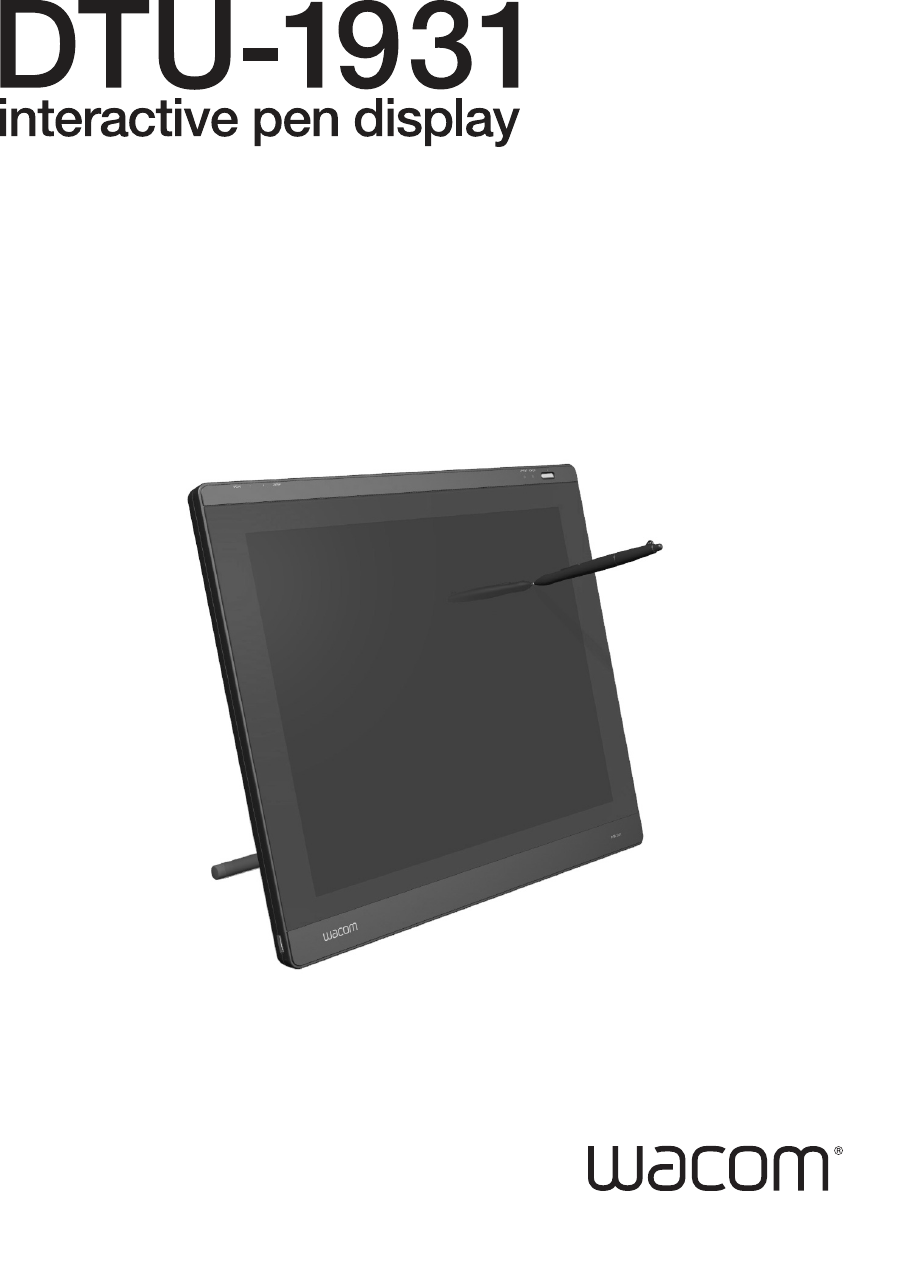
Installation Guide & User’s Manual
설치 및 사용 설명서
安裝指南及使用手冊
安装指南及用户手册
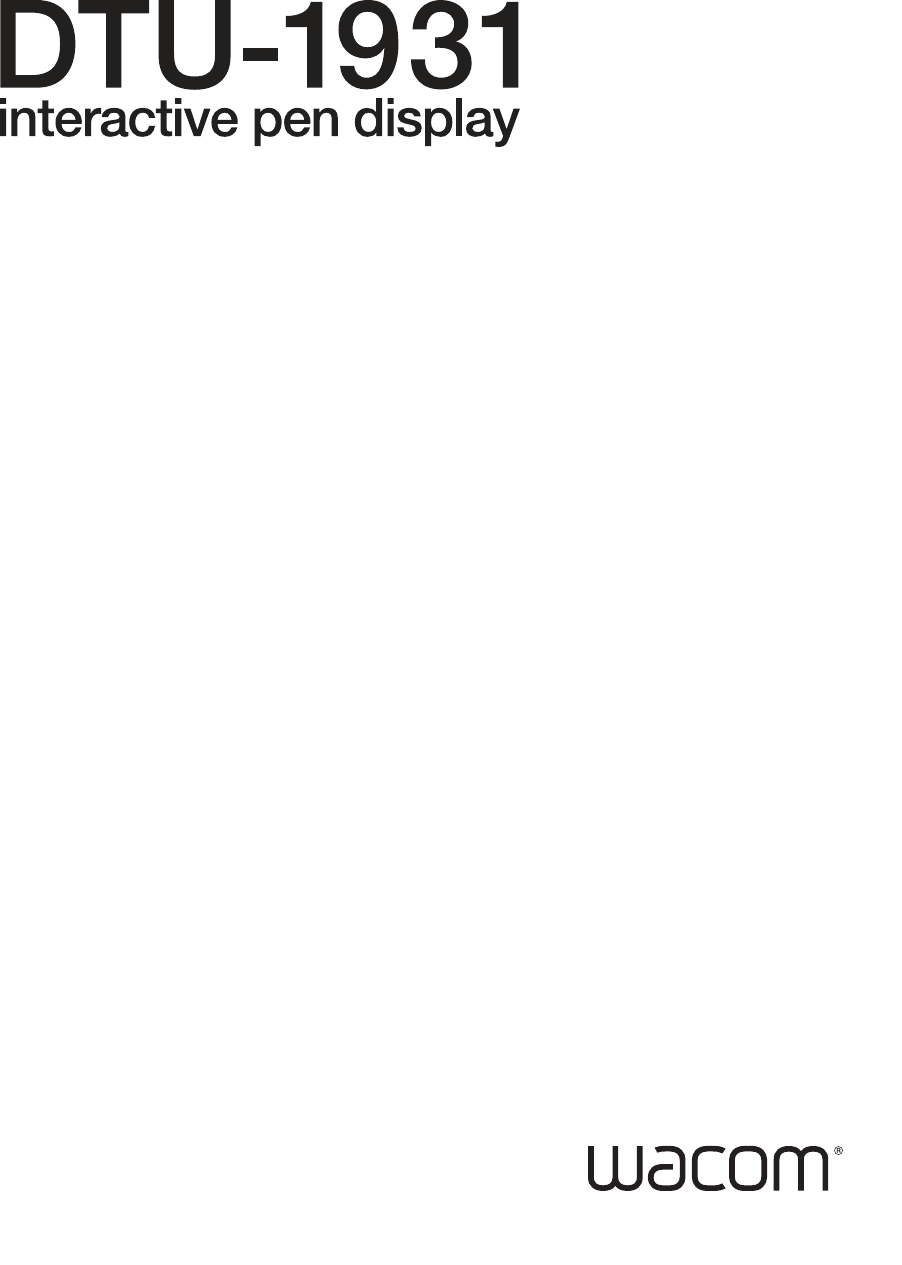
Installation Guide & User’s Manual
DTU-1931A
Installation Guide & User’s Manual
Version 1.0, June 20, 2008
Copyright © Wacom Co., Ltd., 2008
All rights reserved. No part of this manual may be reproduced except for your express personal use.
Wacom reserves the right to revise this publication without obligation to provide notification of such changes.
Wacom does its best to provide current and accurate information in this manual. However, Wacom reserves
the right to change any specifications and product configurations at its discretion, without prior notice and
without obligation to include such changes in this manual.
The above date indicates the date when the Wacom Pen Display Installation Guide & User’s Manual was
prepared by Wacom. However, the date of release to the users of the “Manual” is simultaneous with the
introduction into the market of the applicable Wacom product.
DuoSwitch is a trademark, and Wacom is a registered trademark of Wacom Co., Ltd.
Microsoft, Windows, and Vista are either registered trademarks or trademarks of Microsoft Corporation in the
United States and/or other countries. Apple, the Apple logo, and Macintosh are trademarks of Apple
Computer, Inc., registered in the U.S. and other countries.
Any additional company and product names mentioned in this documentation may be trademarked and/or
registered as trademarks. Mention of third-party products is for informational purposes only and constitutes
neither an endorsement nor a recommendation. Wacom assumes no responsibility with regard to the
performance or use of these products.

Introduction and overview
Page 1
INTRODUCTION AND OVERVIEW
The Wacom® DTU-1931 pen display combines the benefits of a Liquid Crystal Display (LCD) with
the control, comfort, and productivity of Wacom’s cordless, battery-free pen technology. This gives
you a direct pen-on-screen interface for your computer.
The basic components of the DTU-1931 include a Wacom pen tablet internally mounted behind a
19.0" diagonal TFT color display, and a Wacom pen.
The display and tablet sensor function as an integrated output and input device. The display
supports resolutions up to 1280 x 1024 pixels at 16.7 million colors. The tablet sensor reports pen
coordinates, pressure, and switch information.
The DTU-1931 also comes equipped with a video pass-thru (DVI-I OUT) port, enabling you to
simultaneously connect a monitor or projector to the pen display.
This manual describes how to install and use your DTU-1931.
The computer treats the DTU-1931 pen display as two separate devices (the display and the
pen tablet). Therefore, the installation process is completed in two stages:
•First install the DTU-1931 as a display.
•Then install the DTU-1931 as a pen tablet.
Both stages require hardware and software installations and adjustments. Please follow all
instructions carefully.
IMPORTANT: You MUST install the Wacom pen tablet driver software for correct pen-on-
screen functionality.
To learn about using the Wacom Tablet control panel to customize your pen display tablet and pen
settings on Windows or Macintosh computers, see Customizing on page 22.
The following information is not included with this product: information about your specific computer
hardware or operating system, or information about your application software. Your best source for
this information is the set of manuals and discs that came with your hardware, operating system, or
application.
Wacom’s philosophy is to continually improve all of its products. As a result, engineering changes
and improvements are made from time to time. Therefore, some changes, modifications, and
improvements may not be covered in this manual.
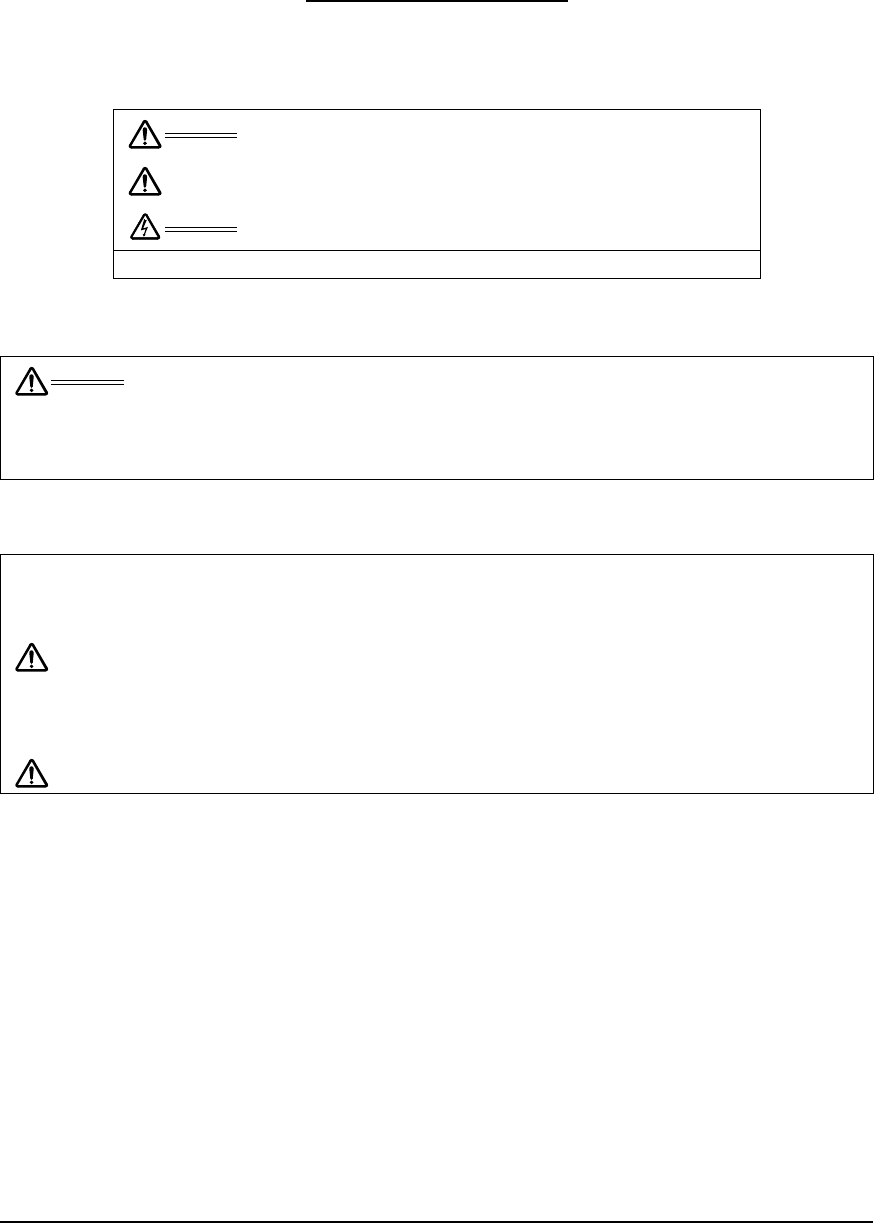
Precautions
Page 2
PRECAUTIONS
To ensure the safe usage of your product, be sure to follow all instructions, cautions, and warnings
found within this manual. Failure to do so could cause the loss of data or damage to your computer.
Failure to do so could also void your warranty, in which case Wacom shall have no responsibility to
repair or replace the product.
PHYSICAL LOCATION
ENVIRONMENT
WARNING This symbol indicates an item that, if disregarded, may lead
to loss of human life or serious injury.
CAUTION This symbol indicates an item that, if disregarded, may lead
to human injury or damage to personal property.
WARNING This symbol indicates an item that, if disregarded, may lead
to loss of human life or serious injury.
Exercise due care and diligence whenever engaging in a described action.
WARNING Do not use the DTU-1931 pen display in a facility control system that requires
extremely high reliability; it may cause other electronic devices to malfunction, or other
devices may cause the pen display to malfunction. Where use is prohibited, power off the
DTU-1931 to prevent the possibility of it causing other electronic devices to malfunction.
Wacom does not accept any liability for direct or consequential damages. For details,
please refer to your Warranty located at the end of this guide.
Temperature and humidity
• Operating temperature and humidity: 5° to 35°C, 20 to 80% RH
• Storage temperature and humidity: -20° to 60°C, 20 to 90% RH
CAUTION Do not use or store the pen display where:
• Temperature changes are severe or exceed specifications (e.g., outdoors or inside a
vehicle).
• The pen display and pen are exposed to direct sunlight or heat from an appliance, or
are exposed to water or any other kind of liquid.
CAUTION Do not use the pen display in a dusty environment; this may damage the unit.
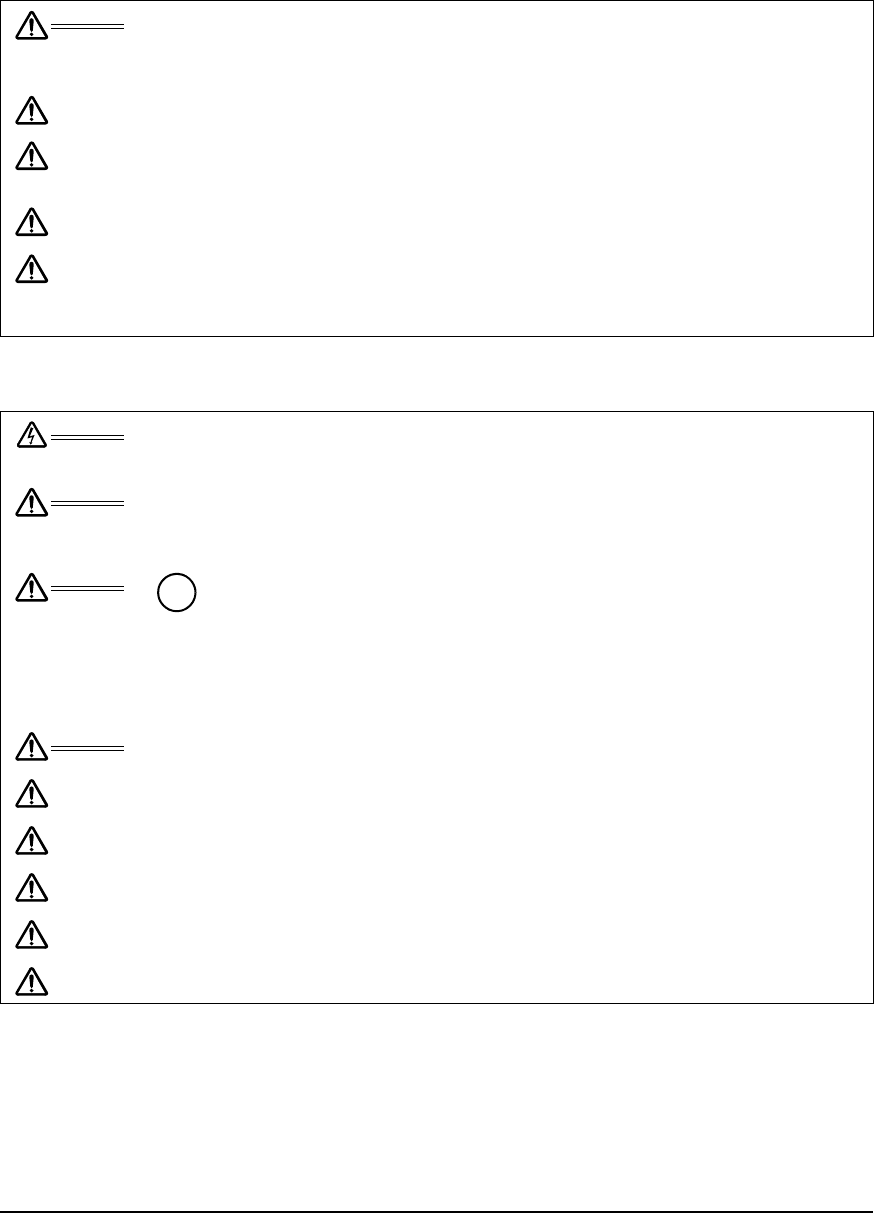
Precautions
Page 3
USAGE
HANDLING
WARNING Only use the power adapter that came with the DTU-1931. If a different type of power
adapter is used, the DTU-1931 will not work properly or may be damaged. Using a
different type of power adapter also has the potential to result in fire. Use of a
different power adapter will void your warranty.
CAUTION Be sure to use a grounded power source when applying power to the DTU-1931.
CAUTION Do not connect or disconnect the video or power cables while the DTU-1931 or your
computer are turned on; this may damage the display or computer video card. In this
case, Wacom shall have no responsibility to repair or replace the product.
CAUTION This product is for use with a VGA or DVI video card; using an inappropriate video
card may damage the DTU-1931.
CAUTION Do not block the rear panel ventilation holes; this may overheat and damage the unit.
When not using the DTU-1931 for long periods of time, unplug the power adapter
from the AC outlet.
WARNING High Voltage. Do not open or disassemble the DTU-1931 pen display. There is a
risk of electrical shock when the casing is open. This will also void your warranty and
Wacom shall have no responsibility to repair or replace the product.
WARNING If the LCD screen has been damaged, DO NOT touch any liquid that may be leaking
from it; this liquid is an irritant. In case of contact with skin, eyes, or mouth, rinse
immediately with running water for at least 15 minutes or more. If contact is made with the
eyes or mouth, also consult a physician.
WARNING
– LAMP(S) INSIDE THIS PRODUCT CONTAIN MERCURY AND MUST
BE RECYCLED OR DISPOSED OF ACCORDING TO REGULATIONS IN
YOUR COUNTRY OR REGION.
The DTU-1931 pen display has a backlight which contains mercury (Hg). Be sure to
dispose of properly, and to manage any disposal of this unit in accordance with your local
ordinances and laws.
WARNING Prevent children from swallowing the pen tip or side switch. The pen tip or side
switch may accidentally be pulled out if children are biting on them.
CAUTION Do not disassemble the pen. This may cause the device to malfunction. In this case,
Wacom shall have no responsibility to repair or replace the product.
CAUTION Do not scratch the display screen. Avoid placing sharp objects on the display screen
surface.
CAUTION When adjusting the tilt angle of the pen display, be careful to avoid catching your
finger in the gap of the movable portion of the stand.
CAUTION Do not lift the DTU-1931 by the stand; this may damage the stand mechanism.
When lifting or moving the pen display, always do so by grasping the main body casing.
CAUTION Avoid intensive shock or vibration to the DTU-1931 or the pen. Hitting or dropping the
pen display may damage the display screen or other components.
Hg
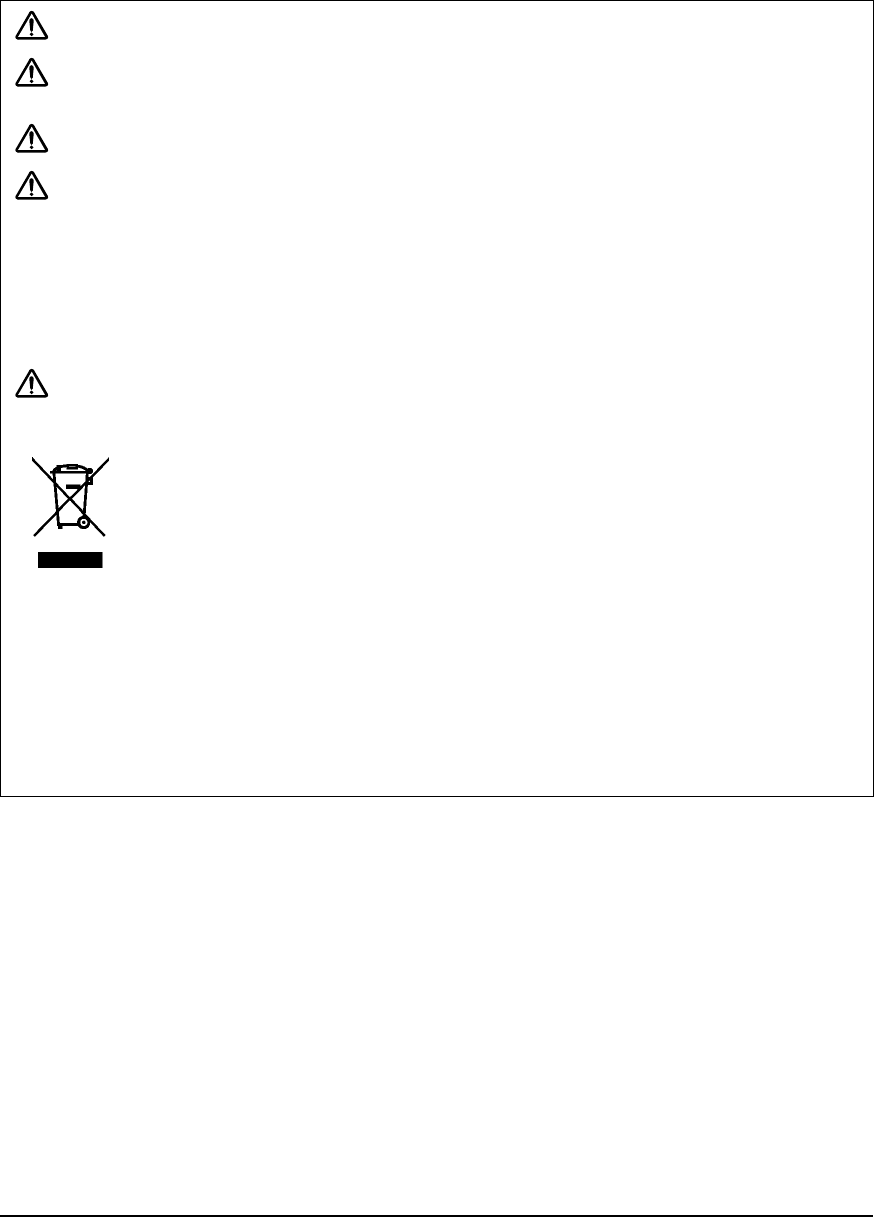
Precautions
Page 4
CAUTION Do not put heavy articles on the pen display or push against it with a strong force;
this may damage the display screen or bend the stand.
CAUTION Do not place heavy articles on the DTU-1931 cabling, repeatedly bend the cables
sharply, or apply heavy stress to the cable connectors; this may damage the unit or
cabling.
CAUTION If the pen tip becomes sharp or angular, it may damage the coating on the display
screen. Replace the pen tip if necessary.
CAUTION Do not use any organic solvent (e.g., alcohol) or even mild detergent to clean
the display screen. Use of these cleaners can damage the coating on the screen.
Please note that damage of this kind is not covered by the manufacturer’s warranty.
• Before cleaning, always disconnect your product from the AC power source.
• To clean the display screen, use an anti-static cloth or a slightly damp cloth.
When cleaning, apply only a light amount of pressure to the display screen and do
not make the surface wet.
• To clean the pen display casing or pen, use a soft cloth with mild detergent (such as
dish washing liquid) diluted with water.
CAUTION Do not expose the DTU-1931 to high voltage electrostatic discharges or to a build-
up of an electrostatic charge on the LCD screen. This may result in a temporary
discoloration and blotching of the display. If discolorations occur, leave the display on and
the discolorations should disappear within a few hours.
Reuse, recycling and recovery. You are urged to recycle this product when replacing it
with a newer product or when it has outlived its useful life by bringing it to an appropriate
collection point for recyclable materials in your community or region. By doing this, you
can help improve the environment of your community as well as minimize the potential
negative effects created, should any hazardous substance that may possibly be present
within waste material reach the environment during the disposal process.
Within the European Union, users are required not to dispose of Waste Electrical and
Electronic Equipment (WEEE) as unsorted municipal waste, according to the Directive
2002/96/EC of the European Parliament and of the Council of 27 January 2003, or the
corresponding local laws of the Member States. Products for which this is applicable will
be marked with the WEEE symbol shown at the beginning of this note unless this is not
feasible because of the size or the function of the product. Wacom products are subject to
the Directive 2002/96/EC and therefore you should always collect them separately and
bring them to the appropriate collection point in your community or region.
Wacom pen display products comply with the European Union RoHS Directive
2002/95/EC (RoHS Directive).

Precautions
Page 5
CONTENTS
Introduction and overview . . . . . . . . . . . . . . . . . . . . . . . . . . . . . . . . . . . . . . . . .1
Precautions . . . . . . . . . . . . . . . . . . . . . . . . . . . . . . . . . . . . . . . . . . . . . . . . . . . . .2
Physical location . . . . . . . . . . . . . . . . . . . . . . . . . . . . . . . . . . . . . . . . . . . . . .2
Environment . . . . . . . . . . . . . . . . . . . . . . . . . . . . . . . . . . . . . . . . . . . . . . . . . .2
Usage . . . . . . . . . . . . . . . . . . . . . . . . . . . . . . . . . . . . . . . . . . . . . . . . . . . . . .3
Handling . . . . . . . . . . . . . . . . . . . . . . . . . . . . . . . . . . . . . . . . . . . . . . . . . . . . .3
Your new DTU-1931 . . . . . . . . . . . . . . . . . . . . . . . . . . . . . . . . . . . . . . . . . . . . . . .7
Package contents . . . . . . . . . . . . . . . . . . . . . . . . . . . . . . . . . . . . . . . . . . . . .7
Pen display components . . . . . . . . . . . . . . . . . . . . . . . . . . . . . . . . . . . . . . . .8
Front view . . . . . . . . . . . . . . . . . . . . . . . . . . . . . . . . . . . . . . . . . . . . . . . .8
Rear View . . . . . . . . . . . . . . . . . . . . . . . . . . . . . . . . . . . . . . . . . . . . . . . .9
Adjusting display incline . . . . . . . . . . . . . . . . . . . . . . . . . . . . . . . . . . . . . . . .10
Installation . . . . . . . . . . . . . . . . . . . . . . . . . . . . . . . . . . . . . . . . . . . . . . . . . . . . . 11
System requirements . . . . . . . . . . . . . . . . . . . . . . . . . . . . . . . . . . . . . . . . . .11
Step 1: LCD monitor installation . . . . . . . . . . . . . . . . . . . . . . . . . . . . . . . . .12
LCD monitor cabling diagram . . . . . . . . . . . . . . . . . . . . . . . . . . . . . . . .13
Step 2: Pen tablet installation . . . . . . . . . . . . . . . . . . . . . . . . . . . . . . . . . . .16
USB cable installation . . . . . . . . . . . . . . . . . . . . . . . . . . . . . . . . . . . . . .16
Pen tablet cabling diagram . . . . . . . . . . . . . . . . . . . . . . . . . . . . . . . . . .16
Software installation . . . . . . . . . . . . . . . . . . . . . . . . . . . . . . . . . . . . . . .17
Working with your DTU-1931 . . . . . . . . . . . . . . . . . . . . . . . . . . . . . . . . . . . . . .18
Setting up your work area . . . . . . . . . . . . . . . . . . . . . . . . . . . . . . . . . . . . . .18
Using the pen . . . . . . . . . . . . . . . . . . . . . . . . . . . . . . . . . . . . . . . . . . . . . . . .19
Pen components . . . . . . . . . . . . . . . . . . . . . . . . . . . . . . . . . . . . . . . . . .19
Basic pen operations . . . . . . . . . . . . . . . . . . . . . . . . . . . . . . . . . . . . . .20
How to use the Tablet Buttons . . . . . . . . . . . . . . . . . . . . . . . . . . . . . . . . . . .21
Component Functions . . . . . . . . . . . . . . . . . . . . . . . . . . . . . . . . . . . . .21
Customizing . . . . . . . . . . . . . . . . . . . . . . . . . . . . . . . . . . . . . . . . . . . . . . . . . . .22
Opening the control panel . . . . . . . . . . . . . . . . . . . . . . . . . . . . . . . . . . . . . .22
Learning more . . . . . . . . . . . . . . . . . . . . . . . . . . . . . . . . . . . . . . . . . . . . . . .22
Customization basics . . . . . . . . . . . . . . . . . . . . . . . . . . . . . . . . . . . . . . . . . .23
Calibrating the DTU-1931 . . . . . . . . . . . . . . . . . . . . . . . . . . . . . . . . . . .24
Adjusting the display . . . . . . . . . . . . . . . . . . . . . . . . . . . . . . . . . . . . . . . . . .25
Factory presets, auto-sync, and user settings . . . . . . . . . . . . . . . . . . .25
On Screen Display (OSD) settings . . . . . . . . . . . . . . . . . . . . . . . . . . . .25
Adjusting pitch and phase (VGA only) . . . . . . . . . . . . . . . . . . . . . . . . .28
Power saving . . . . . . . . . . . . . . . . . . . . . . . . . . . . . . . . . . . . . . . . . . . .28
Troubleshooting . . . . . . . . . . . . . . . . . . . . . . . . . . . . . . . . . . . . . . . . . . . . . . . .29
Testing the DTU-1931 . . . . . . . . . . . . . . . . . . . . . . . . . . . . . . . . . . . . . . . . .29
Testing your pen . . . . . . . . . . . . . . . . . . . . . . . . . . . . . . . . . . . . . . . . . . . . .31
Display troubleshooting . . . . . . . . . . . . . . . . . . . . . . . . . . . . . . . . . . . . . . . .32
General display problems . . . . . . . . . . . . . . . . . . . . . . . . . . . . . . . . . . .32
VGA problems . . . . . . . . . . . . . . . . . . . . . . . . . . . . . . . . . . . . . . . . . . .33
Pen tablet troubleshooting . . . . . . . . . . . . . . . . . . . . . . . . . . . . . . . . . . . . . .34
General problems . . . . . . . . . . . . . . . . . . . . . . . . . . . . . . . . . . . . . . . . .34
Windows-specific problems . . . . . . . . . . . . . . . . . . . . . . . . . . . . . . . . .37
Macintosh-specific problems . . . . . . . . . . . . . . . . . . . . . . . . . . . . . . . .38

Precautions
Page 6
Technical support options . . . . . . . . . . . . . . . . . . . . . . . . . . . . . . . . . . . . . . 39
Obtaining driver downloads . . . . . . . . . . . . . . . . . . . . . . . . . . . . . . . . . . . . 40
Appendix . . . . . . . . . . . . . . . . . . . . . . . . . . . . . . . . . . . . . . . . . . . . . . . . . . . . . 41
Caring for the DTU-1931 . . . . . . . . . . . . . . . . . . . . . . . . . . . . . . . . . . . . . . 41
Cleaning . . . . . . . . . . . . . . . . . . . . . . . . . . . . . . . . . . . . . . . . . . . . . . . 41
Replacing the pen tip . . . . . . . . . . . . . . . . . . . . . . . . . . . . . . . . . . . . . . 41
Using an alternate mount or stand . . . . . . . . . . . . . . . . . . . . . . . . . . . . . . . 42
Pen and digital ink capabilities in Windows Vista . . . . . . . . . . . . . . . . . . . . 43
About the Windows Vista Tablet PC Input Panel . . . . . . . . . . . . . . . . 44
Uninstalling the DTU-1931 . . . . . . . . . . . . . . . . . . . . . . . . . . . . . . . . . . . . . 45
Product specifications . . . . . . . . . . . . . . . . . . . . . . . . . . . . . . . . . . . . . . . . . 46
General specifications . . . . . . . . . . . . . . . . . . . . . . . . . . . . . . . . . . . . . 46
Display . . . . . . . . . . . . . . . . . . . . . . . . . . . . . . . . . . . . . . . . . . . . . . . . . 46
Pen tablet . . . . . . . . . . . . . . . . . . . . . . . . . . . . . . . . . . . . . . . . . . . . . . 46
Power adapter . . . . . . . . . . . . . . . . . . . . . . . . . . . . . . . . . . . . . . . . . . . 47
Pen (Model UP-817E) . . . . . . . . . . . . . . . . . . . . . . . . . . . . . . . . . . . . . 47
Ordering parts and accessories . . . . . . . . . . . . . . . . . . . . . . . . . . . . . . . . . 47
Radio and television interference . . . . . . . . . . . . . . . . . . . . . . . . . . . . . . . . 48
Federal Communications Commission (FCC) statement . . . . . . . . . . 48
Industry Canada (IC) statement . . . . . . . . . . . . . . . . . . . . . . . . . . . . . 49
CE declaration (applicable to the Europe) . . . . . . . . . . . . . . . . . . . . . . 50
Warranty for Asia Pacific (excluding Japan, China and Hong Kong) . . . . . 50
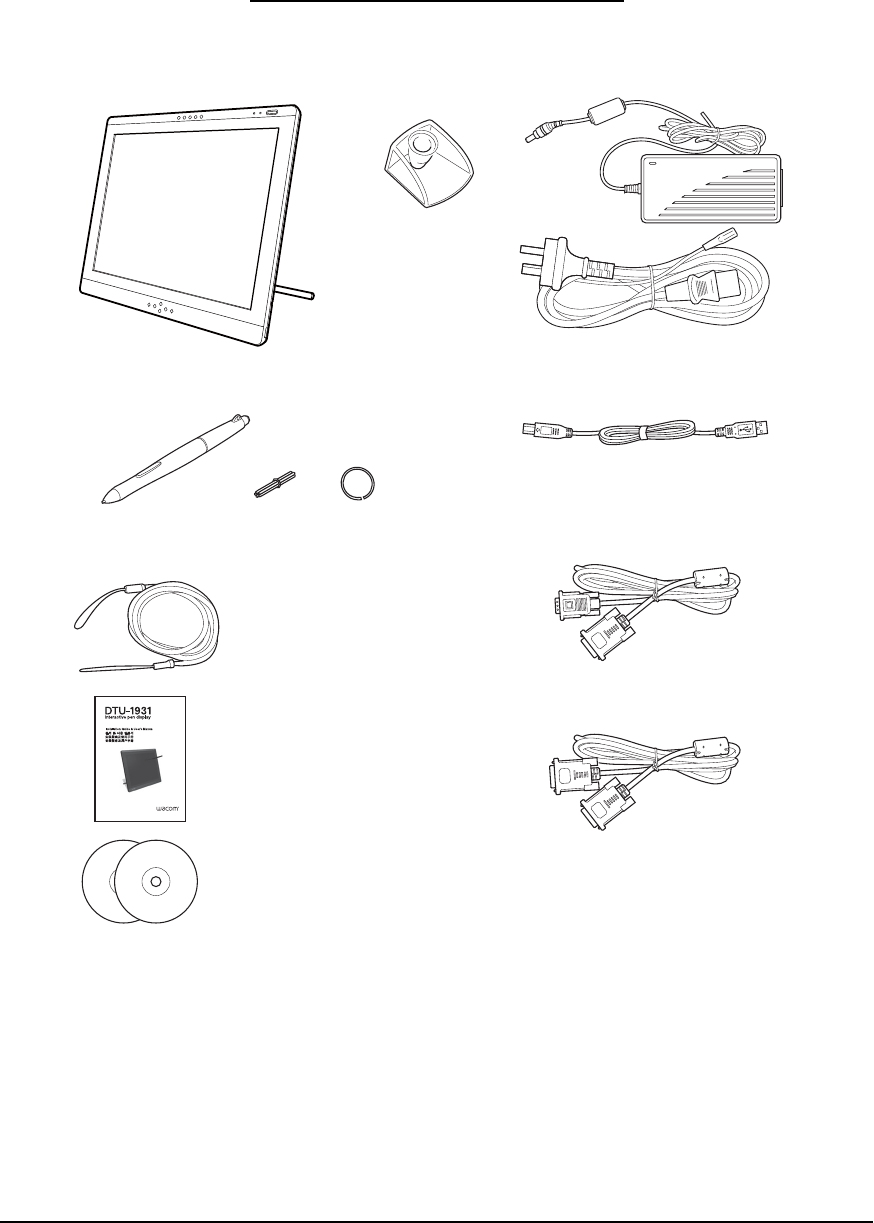
Your new DTU-1931
Page 7
YOUR NEW DTU-1931
PACKAGE CONTENTS
Carefully unpack all items and place them on a stable desktop or work surface. Verify the contents
are complete.
Notes:
Images not shown to scale.
Some product configurations may come with different pens having no side switches or eraser.
Some configurations may include additional CDs or DVDs containing application software. To install these
applications, review the instructions that came with those CDs or DVDs.
Retain the package box for use when storing or shipping the DTU-1931.
l
DTU-1931 pen display
Power adapters and regional
cables / plugs
Pen with replacement nibs
and nib removal tool
USB cable
Installation Guide & User’s Manual
(this manual)
Wacom Pen Tablet Driver CD
(contains the driver software)
Bundled Software CD
Pen tether
DVI to DVI cable
Analog RGB cable
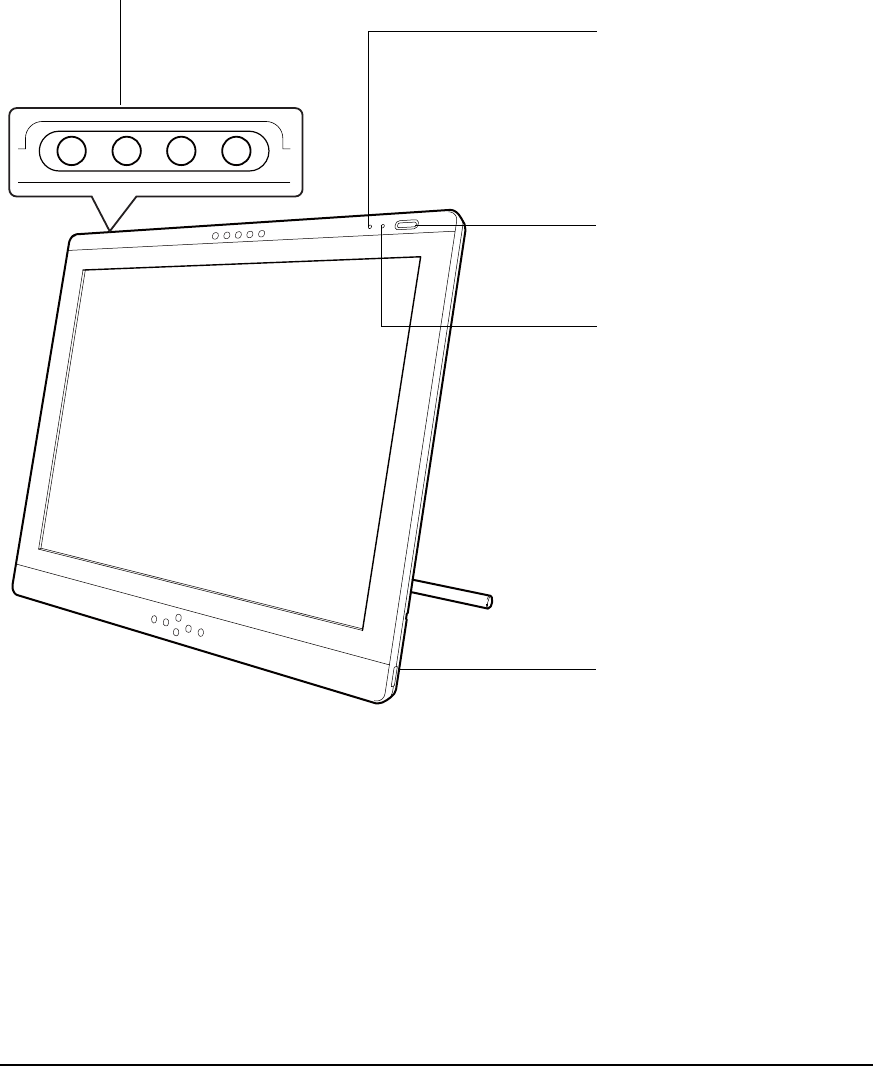
Your new DTU-1931
Page 8
PEN DISPLAY COMPONENTS
Familiarize yourself with the many features and components of your product.
FRONT VIEW
On Screen Display (OSD) controls
These controls enable you to adjust a variety
of display settings. See Adjusting the
display on page 25.
Status LED
Lights blue when the pen is in
the active area of the pen display
tablet and the pen tip is pressed.
The USB cable must also be
plugged into an active USB port
before the LED will light.
Power switch
Turns power to the unit on or off.
Power LED
Lights blue when power has
been supplied to the DTU-1931
and a video signal is present.
Glows orange when no video
signal is detected by the
DTU-1931. (e.g., Your computer
is turned off, starting up, or has
entered a power management
mode in which video signals are
not sent.)
Use the integrated USB ports
(one located on each side of the
unit) to connect a USB device
(e.g., a USB Flash Drive or a
USB remote controller).
Be sure to fully install the
DTU-1931 hardware and
software before connecting any
other devices to the unit.
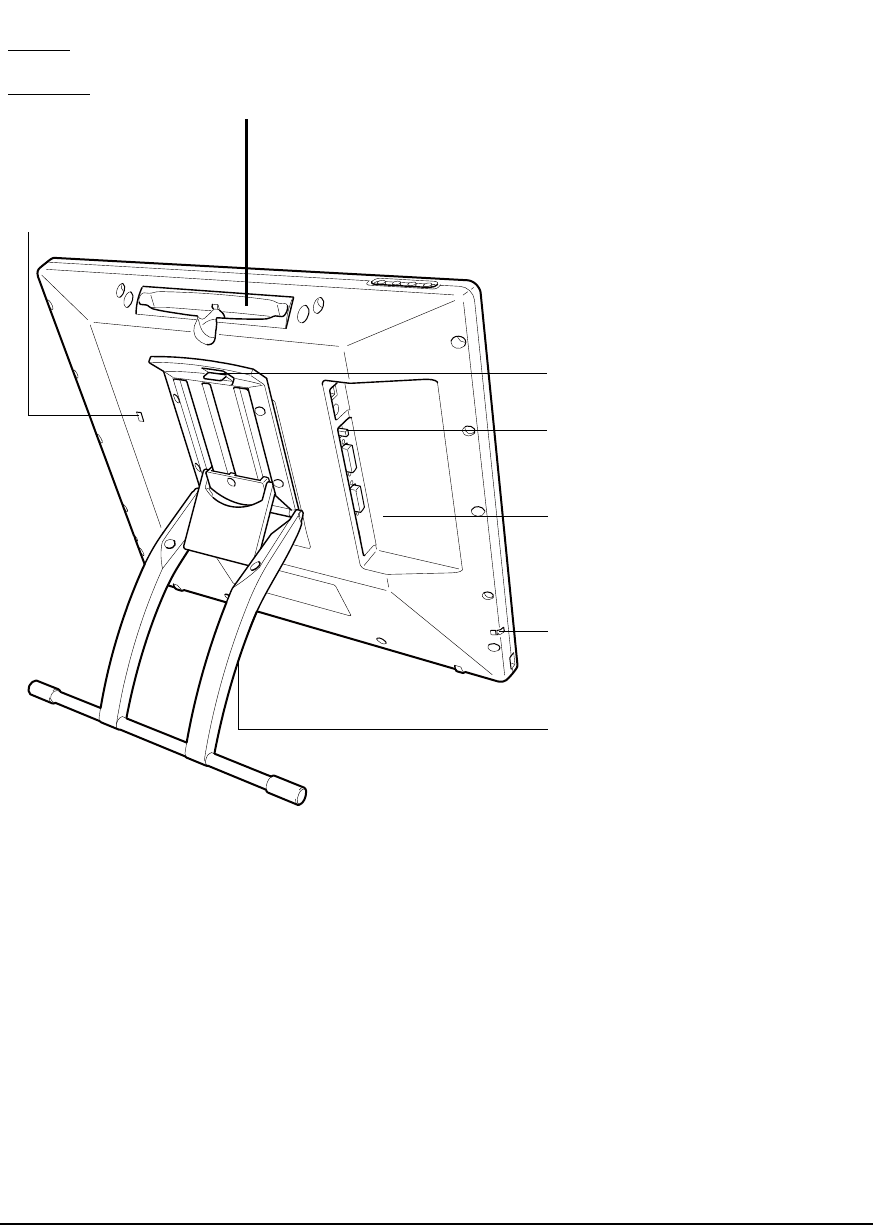
Your new DTU-1931
Page 9
REAR VIEW
Kensington security slot
Allows easy attachment of a
security cable.
Pen storage compartment
To store, insert one end of the pen into either side of the compartment.
Then gently press the other end of the pen into the compartment.
To r e m o v e , press in on either end of the pen. This will pop the opposite end
out of the compartment so you can remove the pen.
Stand adjustment lever
DVI/VGA (digital/analog) switch
Set this switch for the video connection
you will be using.
Video, USB, and power connectors
Stand
Adjusts the tilt angle of the unit.
See Adjusting display incline on
page 10.
Pen tether attachment point
If using a pen tether, connect it to the
attachment point located on the left or
right side of the unit.
IMPORTANT: Always store the pen display on a stable surface or in its original packing carton when
not in use. Be sure to adjust the stand to the low tilt position before packaging the DTU-1931. If you
do not close the stand, the notched mechanism may be damaged during transportation and storage.
Do not lift the unit by the stand; this may damage the stand mechanism. When lifting or moving the
DTU-1931, always do so by grasping the main body casing.
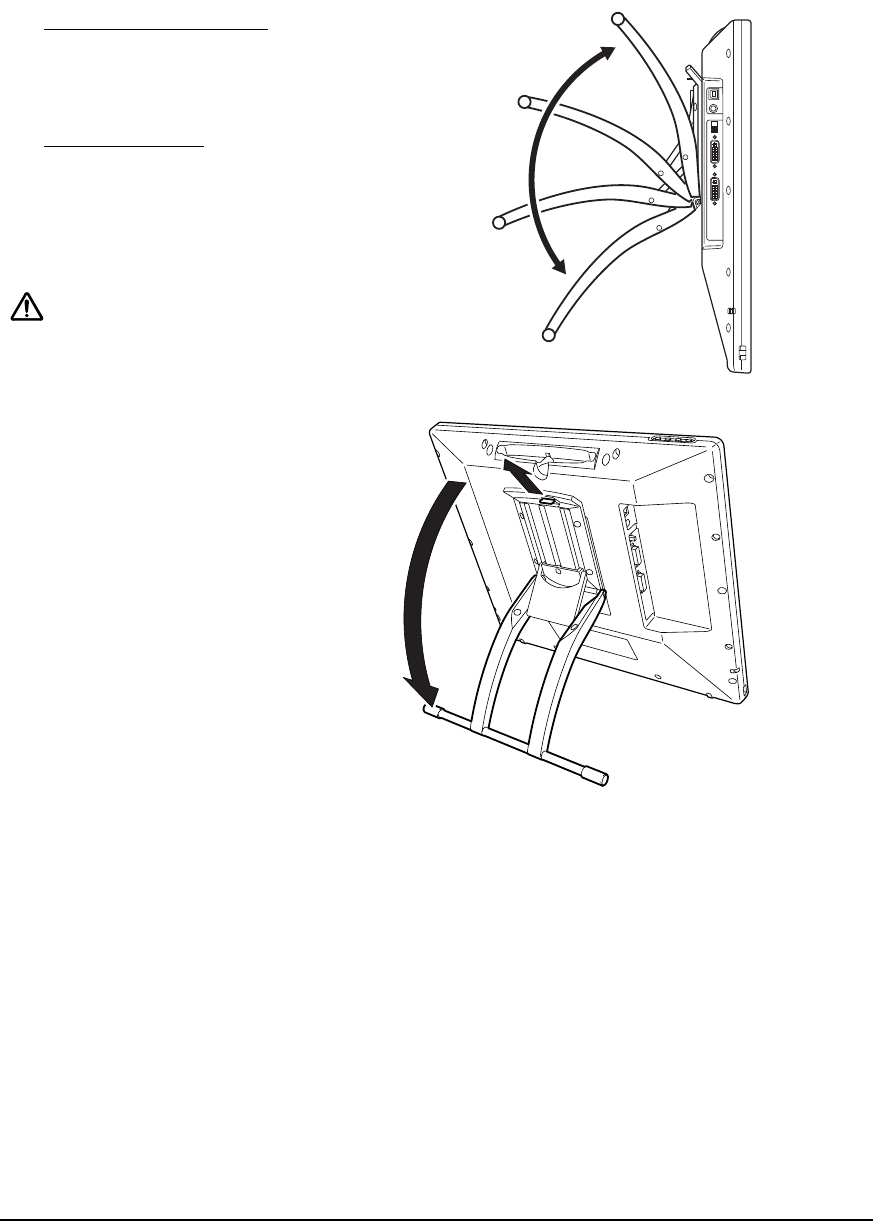
Your new DTU-1931
Page 10
ADJUSTING DISPLAY INCLINE
•To open the display stand, pull up on
the adjustment lever and swing the
stand out to the desired incline.
Release the lever to lock the stand in
place.
•To close the stand, pull up on the
adjustment lever and gently move
the stand back into the closed
position until the latch catches.
Release the lever to lock the stand in
place.
CAUTION
Be careful to avoid catching your finger
in the gap of the movable portion of the
stand.

Installation
Page 11
INSTALLATION
SYSTEM REQUIREMENTS
Before installing the DTU-1931, make sure your computer meets the following minimum system
requirements:
•PC. Windows Vista™, Vista X64, XP, or XP x64. VGA or DVI video connector, available USB
port, and CD-ROM drive.
•Macintosh. OS X, v10.3.9 or greater. VGA or DVI video connector, available USB port, and
CD-ROM drive. ADC connectors require an ADC to DVI adapter, not included.
The DTU-1931 supports both analog (VGA) and digital (DVI) video signals. If updating your video
card, complete the video card hardware and software installation before connecting the DTU-1931.
If you have another display that is compatible with your video card, you can connect that display to
the card in order to verify the video card is operating correctly.
Although you can quickly connect the DTU-1931 to either a VGA or DVI video card, connecting to a
DVI video card generally results in optimum performance.
Notes:
Depending on the capabilities of your video card and operating system, you may be able to set up the
DTU-1931 as a mirrored, extended, or independent display. Refer to your video card documentation for
more information on its capabilities.
When you are working with more than one monitor, the DTU-1931 will map to the monitors based upon
how your system is configured. By default, if you are in mirror mode, the pen tablet will map to the entire
space on each monitor. See your hardware and operating system documentation for details on
configuring your computer and operating system for use with multiple monitors.
A display toggle function is available for use with multiple monitor systems. This enables you to toggle the
screen cursor between the DTU-1931 pen display and your other monitors. For more information, see the
electronic Software User’s Manual.
The DTU-1931 can be used alone or with another display. You may connect a second device, such as a
monitor or LCD projector, to the DTU-1931 DVI-I OUT port. When using this port, the second device will
mirror the image on the DTU-1931. Complete the DTU-1931 installation before connecting a projection
device to the unit.
There are two primary steps to the installation process:
•Step 1: LCD monitor installation
•Step 2: Pen tablet installation
Be sure to follow ALL instructions carefully.
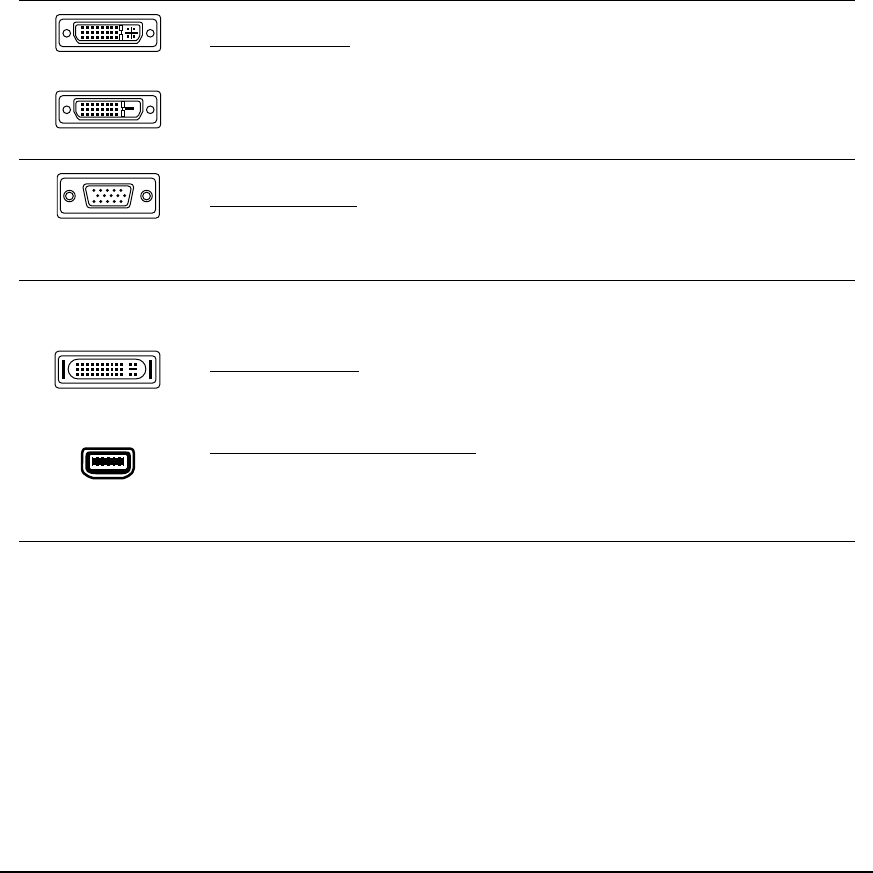
Installation
Page 12
STEP 1: LCD MONITOR INSTALLATION
In this step, the DTU-1931 is installed as a monitor on your system.
IMPORTANT: Do not connect the USB data cable until instructed to do so.
•Turn off your computer.
Caution: Never connect or disconnect the video or power cables while your computer or
DTU-1931 are powered on – this can damage the display or video card.
•If your computer has only one video connector, you will need to unplug your previous monitor or
add a second video card. Determine if your computer has an analog (VGA) or digital (DVI)
connector and set the DVI/VGA switch for the video connection you are using. See – A – in the
connection diagram on page 13.
•Making sure to tighten the thumbscrews on the connectors, follow the instructions below for
your video connector. See – B –.
•Connect the power adapter to the DTU-1931. See – C – on the next page.
•Then connect the adapter’s power cable and plug the adapter into an AC outlet. See – D –.
•Turn on the DTU-1931. The power LED will light orange.
For DVI operation, connect the DTU-1931 DVI to DVI video cable between the
DVI IN connector located on the pen display unit and the DVI-D or DVI-I
connector on your video card.
For VGA operation, connect the DTU-1931analog RGB video cable between the
DVI IN connector located on the pen display unit and the VGA connector on your
video card.
If connecting to an Apple ADC or mini-VGA connection, you will need to obtain
an appropriate adapter. Adapters can be purchased at various retail outlets.
For ADC operation, plug one end of the DTU-1931 DVI to DVI video cable into
the ADC to DVI adapter. Then connect the other end of the DTU-1931 cable to
the DVI IN connector on the pen display unit. Next connect the ADC adapter end
to the ADC connector on your video card.
For an Apple mini-VGA connector, plug the VGA end of the DTU-1931 analog
RGB cable into the mini-VGA port adapter. Then connect the DVI end of the
DTU-1931 cable to the DVI IN connector on the pen display unit. Next connect
the mini-VGA port end to the mini-VGA port on your video card.
DVI-I connector
DVI-D connector
VGA connector
Apple ADC
connector
Mini-VGA port
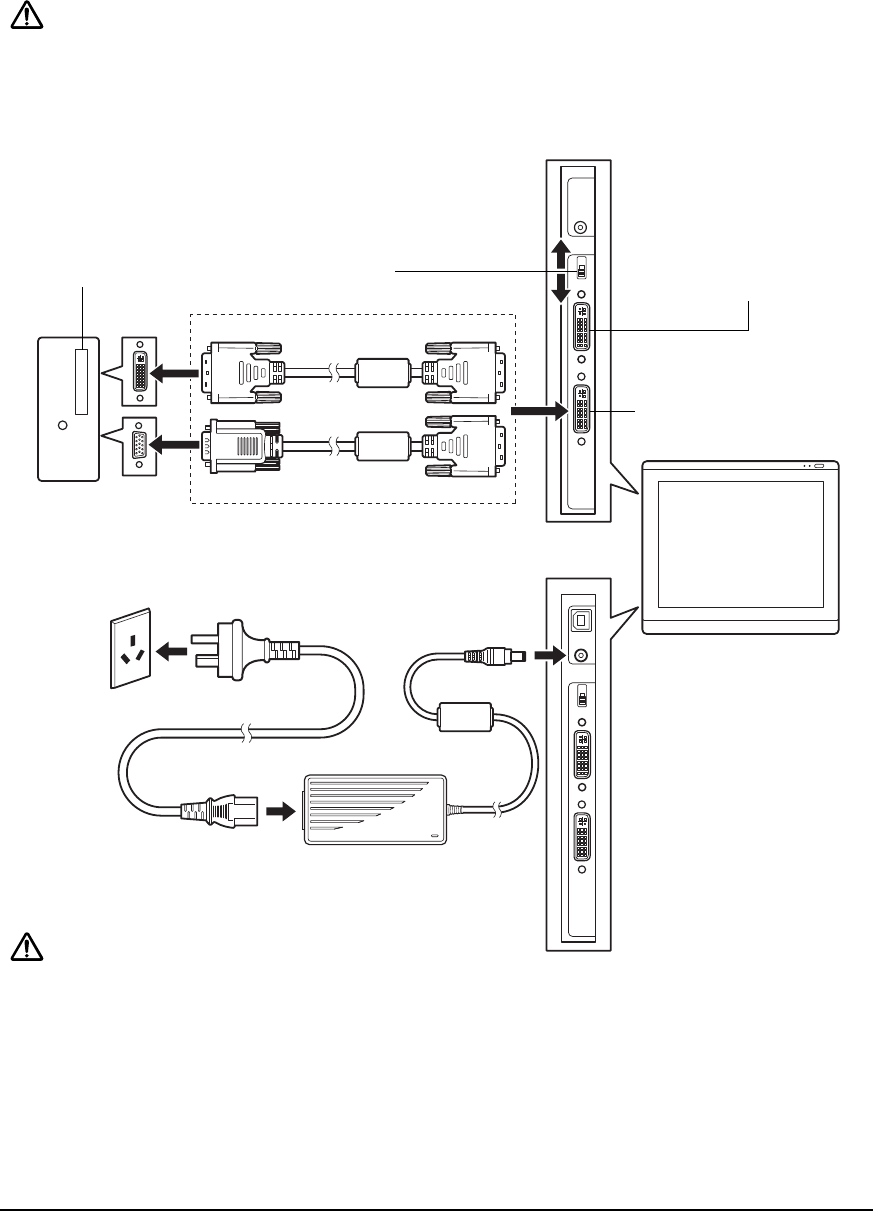
Installation
Page 13
LCD MONITOR CABLING DIAGRAM
CAUTION
Make sure your video card has a VGA or DVI connector, and that you correctly set the DVI/VGA switch
for the video connector you are using.
Do not attach the USB data cable until instructed to do so.
– A –
DVI/VGA switch
Use the DVI-I OUT port to
connect a second device,
such as a projector or
monitor, that mirrors the pen
display.
Fully install the DTU-1931
hardware and software
before connecting a
projection device to the unit.
– B –
Analog RGB cable
or
DVI to DVI cable
VGA or DVI
video card
DVI IN
Rear panel
of computer
– C –
DC input
To AC outlet
Power adapter
– D –
CAUTION
Do not connect or disconnect the video or power cables while the DTU-1931 or your computer are
turned on – this can damage the display or computer video card.
Use only the power adapter that came with the DTU-1931; use of an improper power adapter may
damage the unit.
Make sure that the display refresh rate does not exceed 75 Hz.
Analog (VGA)
Digital (DVI)

Installation
Page 14
•Next, turn on your computer.
For Windows systems: The DTU-1931 will automatically install as a default monitor. If you want
the DTU-1931 to be identified as a DTU-1931 display and if you want to install the color
calibration profile for the DTU-1931, follow the instructions below to update the display driver:
For Macintosh systems, a DTU-1931 color profile will be added to your computer’s color
management system during the tablet software installation process. To activate this color profile
for use with the pen display, you may need to select the DTU-1931 profile in the system’s
ColorSync Utility control panel. For details, see the color management information in your
operating system and application documentation.
1. Open the CONTROL PANEL folder.
•For Windows Vista, under APPEARANCE and PERSONALIZATION select ADJUST
SCREEN RESOLUTION.
•For Windows XP, open the DISPLAY PROPERTIES control panel and select the
SETTINGS tab.
Note: If you have more than one monitor and you need help in determining which display
corresponds to the DTU-1931, click the IDENTIFY MONITORS button. Select the display number
corresponding to the DTU-1931.
2. Click the ADVANCED SETTINGS... button.
3. Select the MONITOR tab and click the PROPERTIES button.
4. Select the DRIVER tab and click the UPDATE DRIVER... button. An update driver dialog or
Wizard will appear.
5. Insert the Wacom Pen Tablet Driver CD. If the Wacom Tablet installation menu displays,
close it.
Windows Vista:
•Select the option BROWSE MY COMPUTER FOR DRIVER SOFTWARE.
•Enter the drive letter for the Wacom Pen Tablet Driver CD and click NEXT.
•After the installation is complete, close any open control panel windows.
Windows XP:
•The Wizard will ask if Windows can search for software. Choose NO, NOT THIS TIME
and click NEXT.
•Select the option INSTALL FROM A LIST OR SPECIFIC LOCATION (ADVANCED), and click
NEXT.
•Select the option DON’T SEARCH. I WILL CHOOSE THE DRIVER TO INSTALL and click
NEXT.
•Select the DTU-1931 pen display option and then click the HAVE DISK... button.
Enter the letter of your CD-ROM drive (e.g., E:\), and click OK.
•Follow the prompts to continue. (If the HARDWARE INSTALLATION dialog box displays,
click CONTINUE ANYWAY to accept the driver.) After the installation is complete, click
the FINISH button and close any open control panel windows.

Installation
Page 15
•As necessary, configure the display control panel settings for the proper size and color
resolution. The maximum (native) resolution of the DTU-1931 is 1280 x 1024 pixels.
The display size and color resolution may be constrained by the capabilities of your video card.
See the video card manufacturer’s documentation for details.
Windows: If you are using the DTU-1931 as a secondary display, you may first need to enable
the DTU-1931 in your Display Properties control panel.
•To fine-tune the display, refer to Adjusting the display, beginning on page 25. If using analog
(VGA) mode, see also Adjusting pitch and phase (VGA only) on page 28.
•After the LCD monitor portion of the DTU-1931 is working to your satisfaction, move on to Step
2: Pen tablet installation to install the pen tablet portion of the DTU-1931.
•For troubleshooting tips, see page 29.
Notes:
Each DTU-1931 LCD panel is produced under very stringent quality standards. Production techniques
cannot guarantee an absolutely perfect TFT display, and some panels may exhibit a certain number of
pixels that show an incorrect color. See the specifications on page 46 for more information.
If an image has fine striping (such as screen stripes), it may appear to flicker or display a moiré pattern.
Do not apply excessive pressure on the display surface, it may cause the appearance of a moiré or pooling
pattern. If this occurs, use less pressure on the display screen when working with the pen.
When a still image is displayed for a long period of time, an after-image may remain for a short time.
To prevent this, Wacom recommends using a screen saver or other power management feature.
IMPORTANT: To extend the life of the backlight, set your computer’s power management to
turn off the display when it is not in use for extended periods of time.
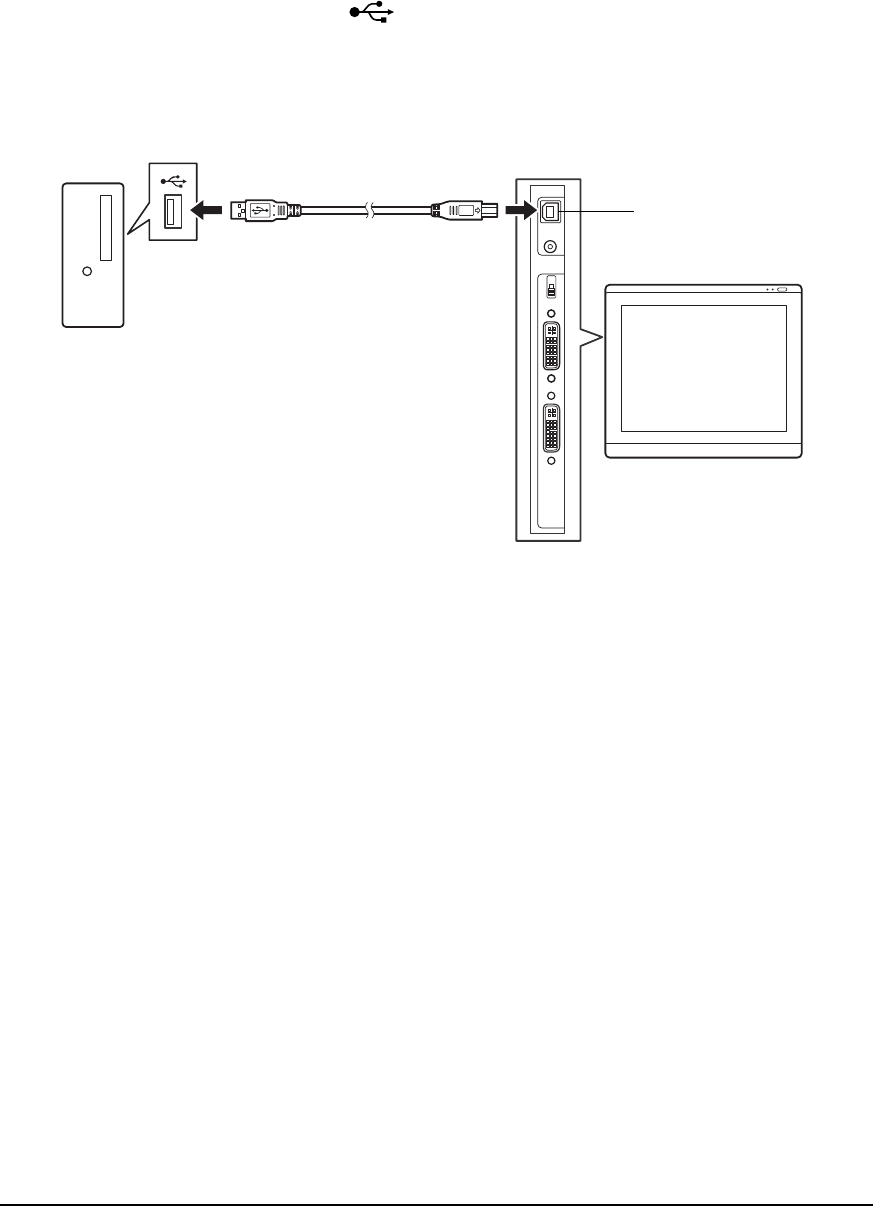
Installation
Page 16
STEP 2: PEN TABLET INSTALLATION
USB CABLE INSTALLATION
Plug the square end of the USB cable into the DTU-1931 port labeled USB. Plug the other end into
an available USB port on your computer or on a USB hub attached to your computer. See – E – in
the diagram below.
Next, move on to the Software installation on page 17.
PEN TABLET CABLING DIAGRAM
– E –
To USB port
Your computer
USB port

Installation
Page 17
SOFTWARE INSTALLATION
IMPORTANT: You MUST install the Wacom pen tablet driver software for correct pen-on-
screen functionality.
To install the tablet software:
•Save your work and close all open applications. Temporarily disable any virus protection
programs.
•Insert the Wacom Pen Tablet Driver CD into your computer’s CD-ROM drive. If the software
installer menu does not automatically display, double-click on the Install icon located on the CD.
•Click on the INSTALL TABLET link and follow the prompts to install the driver software.
•Reactivate your virus protection program.
•After completing the software installation, make sure you can use your pen on the DTU-1931
display to move the screen cursor.
When you place the pen tip on the display screen, the screen cursor should immediately jump
to a corresponding position approximately beneath the pen tip. Lift the pen tip and place it on
the display screen surface in a different location – the screen cursor should again jump to the
new position. This is known as absolute positioning, and enables you to position the screen
cursor without having to drag your pen across the display screen surface.
•Be sure to check the Read Me file for updated information. If you have trouble installing the
DTU-1931, see the Troubleshooting section beginning on page 29.
Notes:
Driver installation automatically activates the new pen input functions available within Microsoft Windows
Vista and Office 2007 (except for Windows Vista Home Basic). Visit the Wacom web site at
www.wacom-asia.com/vista for additional information on using your Wacom pen in Windows Vista.
User-specific preferences are supported. After logging in, each user can customize their personal settings
in the Wacom Tablet control panel. Switching to another user will automatically load the settings for that
user.
To uninstall the tablet driver, see Uninstalling the DTU-1931 on page 45.
If the pen display tablet does not respond properly or you lose cursor control, the tablet preferences may
be corrupted. You can delete the current preference settings and return the tablet to its factory default
condition. On a Windows system, run the TABLET PREFERENCE FILE UTILITY. Access the utility by clicking
on the Windows START icon and selecting ALL PROGRAMS. Then select WACOM TABLET and TABLET
PREFERENCE FILE UTILITY.
Next, adjust the pen display tablet calibration to precisely align the screen cursor to the pen tip.
See Calibrating the DTU-1931 on page 24.

Working with your DTU-1931
Page 18
WORKING WITH YOUR DTU-1931
As you work with the DTU-1931 pen display you can rest your hand lightly on the display screen,
just as if it were a drawing board or sheet of paper.
Because the DTU-1931 surface will be a little higher than your desk, consider adjusting the height of
your desk or chair to assure comfortable use of the device.
SETTING UP YOUR WORK AREA
To minimize fatigue, organize your work area so you can work comfortably. Position your
DTU-1931, the pen, and your keyboard for easy access without unnecessary reaching. The pen
display and any other displays should be positioned so you can view them comfortably with a
minimum of eyestrain.
•Take short breaks between tasks to stretch and relax your muscles.
•Use a gentle grip when working with the pen.
•Alternate tasks throughout the day.
•Maintain a good posture at all times. Minimize awkward postures and repetitive movements
that cause discomfort.
•Change your position if you feel any discomfort due to your work position.
Note: Wacom makes no representation, promise or guarantee that Wacom products will cure or prevent, in
whole or in part, mouse-induced repetitive stress symptoms, injuries or conditions. Individual results may
vary. Always obtain competent medical advice to determine the most appropriate treatment for your
specific situation.
Tips:
Be careful that you do not pull the cables out of their connections by accidentally moving the DTU-1931
too far from the computer.
The pen tether can be used to ensure your pen stays with your pen display tablet. Simply loop one end of
the tether through the tether hole located on the pen (if so equipped), and the other end of the tether
through the tether connection point located on the left or right side of the tablet.
The DTU-1931 can also be mounted to articulated arms or other third-party stands meeting the VESA 100
specification for display stands. For details, see Using an alternate mount or stand on page 42.
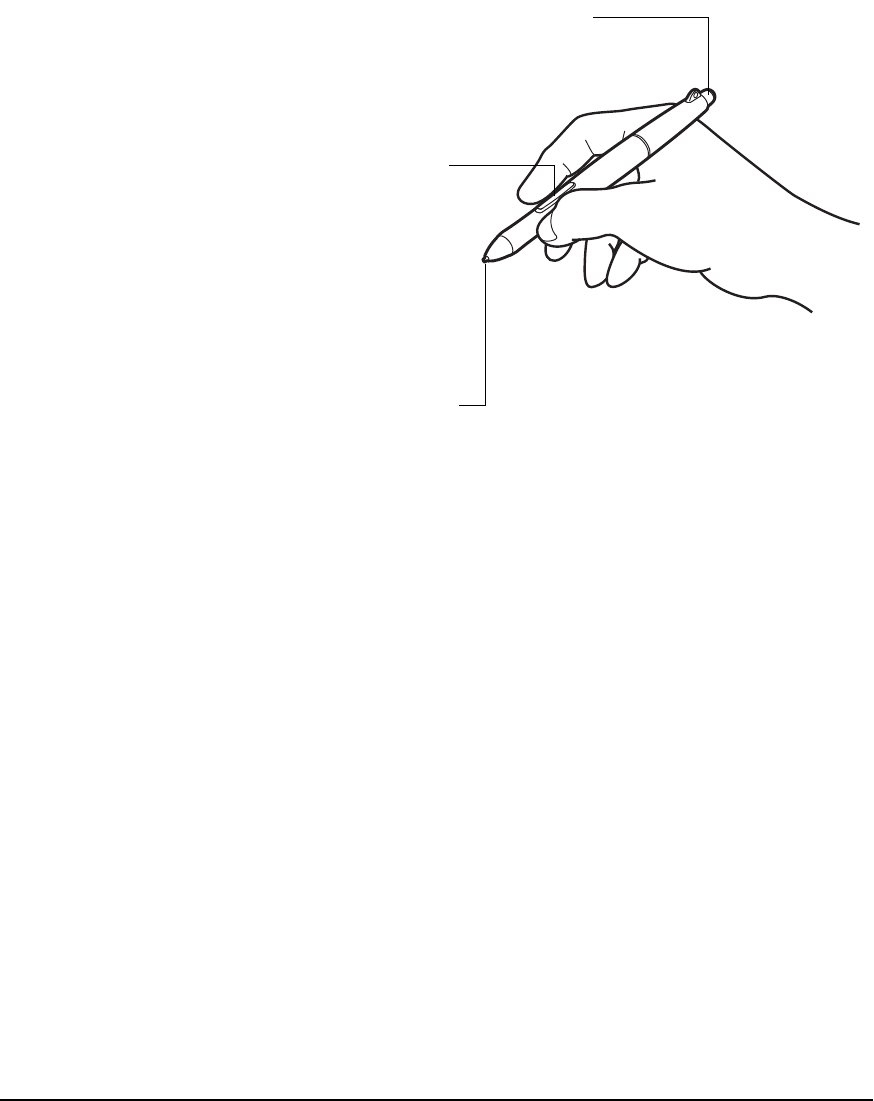
Working with your DTU-1931
Page 19
USING THE PEN
The pen is cordless, battery-free, and senses the amount of pressure you apply to the tip. Hold the
pen like you would a normal pen or pencil. As you work with the DTU-1931, you can rest your hand
lightly on the display screen, just as if it were a drawing board or sheet of paper. You can tilt the pen
in any way that feels most comfortable for drawing.
PEN COMPONENTS
IMPORTANT: Use only the pen that came with your DTU-1931 pen display. Other pens
may not function properly. Also, the DTU-1931 pen tip is specifically designed for use with
the DTU-1931 pen display – the tips on other pens could damage the protective coating on
the pen display screen.
For information on customizing the pen settings, see Customizing on page 22.
Eraser: When equipped and the eraser is brought within 5 mm (0.2 inch)
of the display, the tablet reports the pen location. Pressure information is
reported as you press down on the eraser. By default, the eraser function
is set to ERASE.
Some non-eraser pens may be configured with a pen tether connection
point.
DuoSwitch (side switch): When equipped, make sure
the programmable switch is in a convenient location
where you can toggle it with your thumb or forefinger but
not accidentally press it while writing or drawing. You can
use the switch whenever the pen tip is within 5 mm
(0.2 inch) of the display screen surface; you do not need
to touch the pen tip to the display surface. Toggle the
switch in either direction to activate the button functions.
By default, the upper switch is set to DOUBLE CLICK and
the lower switch is set to RIGHT CLICK.
Pen tip (replaceable nib): The pen is activated as soon
as it is brought within 5 mm (0.2 inch) of the pen display
screen. This allows you to position the screen cursor
without touching the pen tip to the display screen.
When pressure is applied to the pen tip, the pen
simulates a primary mouse button click. The tip click
pressure can be adjusted in the Wacom Tablet control
panel.
Notes:
When the pen is not in use, place it in the pen storage compartment, or lay it flat on your desk.
To maintain the sensitivity of your pen, do not store the pen in a container where it will rest on its tip.
Some product configurations may come with a pen that has no DuoSwitch or eraser. In that case, you
can ignore all explanations within this guide regarding the side switch or eraser.
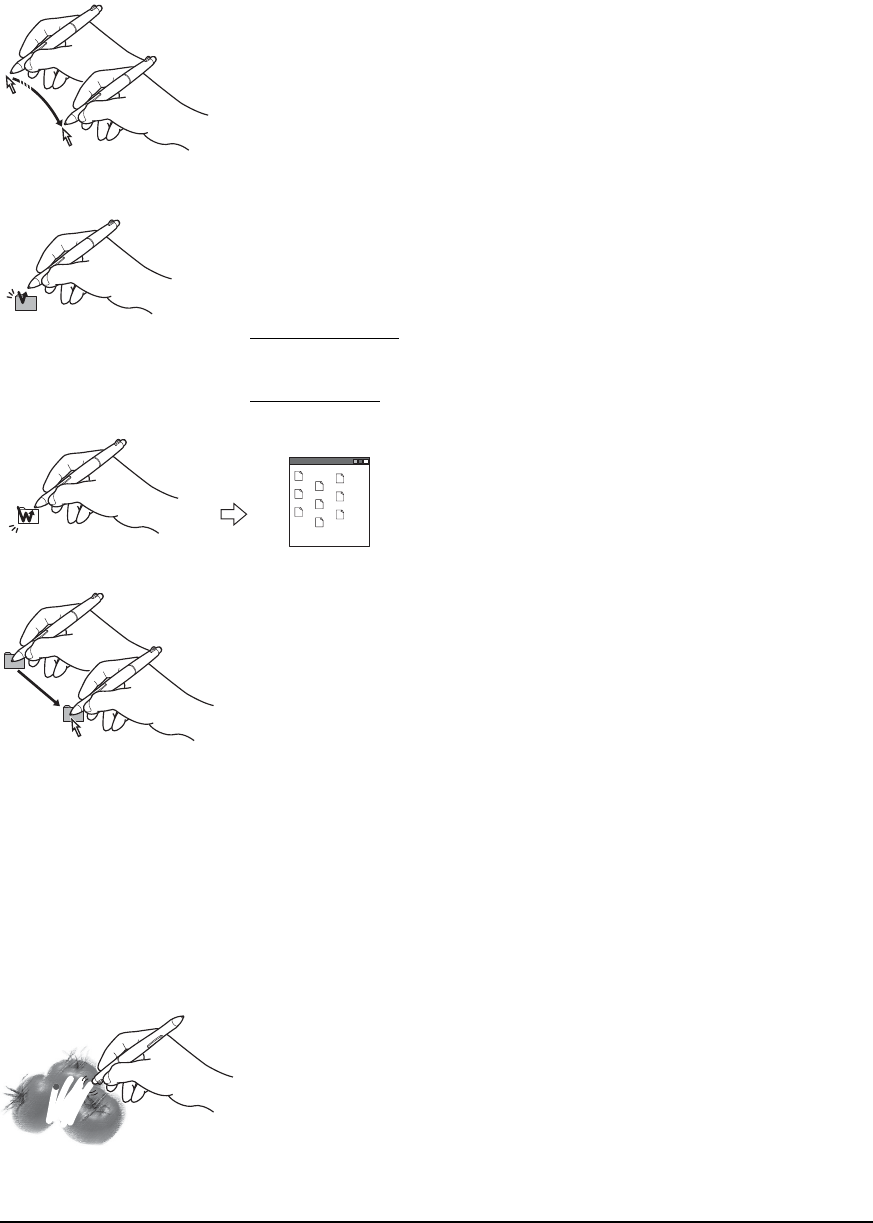
Working with your DTU-1931
Page 20
BASIC PEN OPERATIONS
Pointing and selecting: Move the pen slightly above the DTU-1931
display screen to position the screen cursor; you do not need to touch
the display surface. The cursor jumps to the location where you place
the pen. Press the pen tip on the display screen to make a selection.
Note: You must calibrate the pen display tablet to correctly align the screen
cursor with the pen tip. (See Calibrating the DTU-1931 on page 24.) If the
screen cursor does not jump to a position close to the pen tip when you place
the pen on the display screen, then the pen tablet driver may not be installed or
is not loading. Install the pen tablet driver software if necessary. Otherwise,
see Troubleshooting, beginning on page 29.
Clicking: Tap the display screen once with the pen tip, or touch the
pen to the display screen with enough pressure to register a click.
Windows tip: To make navigating with the pen easier, configure Windows to
select when the pen is over an icon and to launch the icon with a single click.
To turn on this feature, first open a folder.
For Windows Vista, From the ORGANIZE pull-down menu choose FOLDER AND
SEARCH OPTIONS. From the GENERAL tab select SINGLE-CLICK TO OPEN AN ITEM
(POINT TO SELECT).
For Windows XP
, from the TOOLS pull-down menu choose FOLDER OPTIONS....
From the GENERAL tab select SINGLE-CLICK TO OPEN AN ITEM (POINT TO SELECT).
Double-clicking: Press the upper side switch, or
quickly tap the display screen twice in the same place
with the pen tip.
Double-clicking is easier when the pen is
perpendicular to the tablet screen. See the electronic
Software User’s Manual for information on fine-tuning
the double-click area.
Dragging: Select an object, then slide the pen tip across the display
screen to move the object.
Using the side switch: The pen may be equipped with a DuoSwitch. This switch has two
programmable functions that can be selected by rocking the switch in either direction. You can use
the DuoSwitch whenever the pen tip is within 5 mm (0.2 inch) of the display screen surface; you do
not need to touch the pen tip to the display surface in order to use the switch. By default, the upper
switch is set to DOUBLE CLICK, and the lower switch is set to RIGHT CLICK.
Drawing and writing with pressure sensitivity: The pen responds to the nuance and inflection of
your hand movements, enabling you to create natural-looking pen and brush strokes within
applications that support this feature. To draw and write with pressure, select a pressure-sensitive
tool from your application’s tool palette. As you work on the screen surface, use various amounts of
downward pressure on the tip of the pen. Press lightly for thin lines or softer color. Press harder for
thick lines or dense color.
Erasing: In supporting applications, the pen’s eraser works like the
eraser on a pencil. In text applications, use the eraser to select text,
then lift the eraser from the tablet to delete the text.
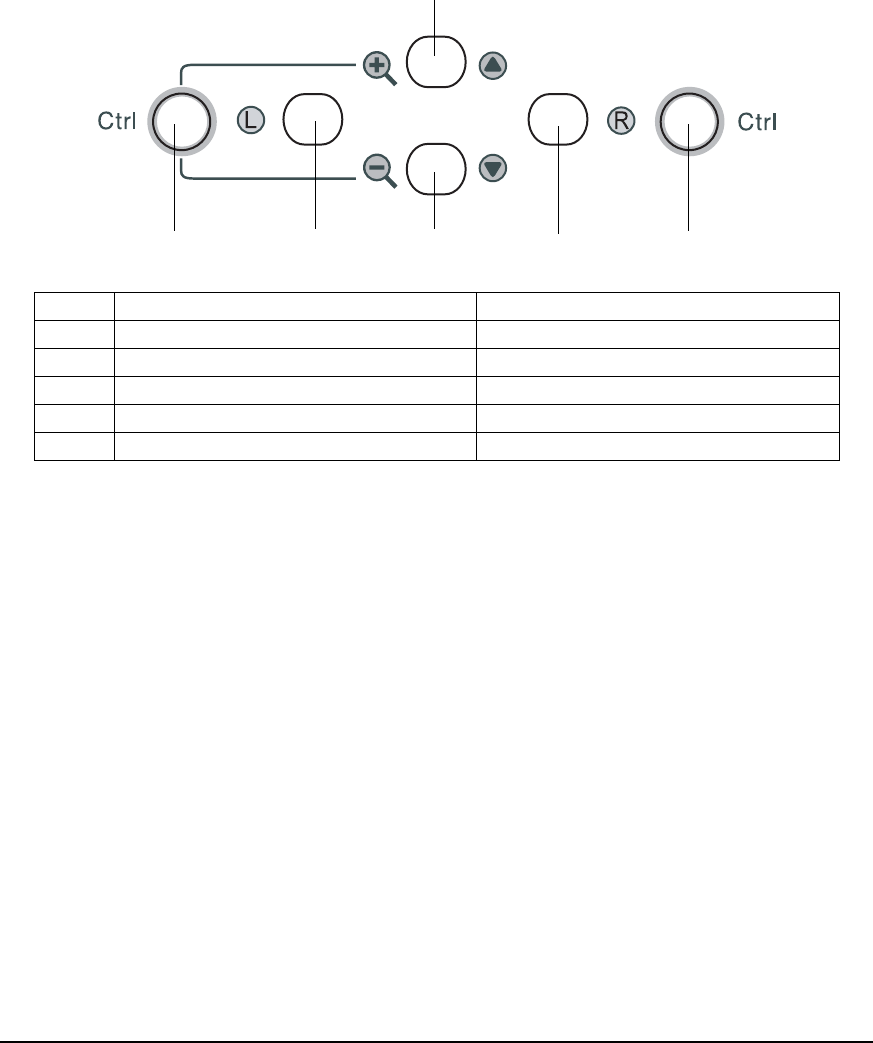
Working with your DTU-1931
Page 21
HOW TO USE THE TABLET BUTTONS
The tablet buttons increase your work efficiency by making navigating through documents and
websites quick and simple.
IMPORTANT: The tablet buttons can be used in Windows-based PCs. To use the tablet
buttons, install the button driver to your PC.
COMPONENT FUNCTIONS
NO Name Function
1 Left mouse button Works like the left mouse button.
2 Right mouse button Works like the right mouse button.
3 Scroll up button Scrolls the window up.
4 Scroll down button Scrolls the window down.
5 Ctrl button Works like the Ctrl button on the keyboard.
3
425
51

Customizing
Page 22
CUSTOMIZING
After you master the basics of using your pen on the DTU-1931 pen display, you may want to
customize the way the pen works. The Wacom Tablet control panel makes it easy to customize the
DTU-1931 and pen.
OPENING THE CONTROL PANEL
To open the control panel, use the DTU-1931 pen on the pen display tablet:
Windows. Click on the Windows START button and choose ALL PROGRAMS.
Then select WACOM TABLET and choose the WACOM TABLET PROPERTIES option.
Macintosh. Open SYSTEM PREFERENCES from either the Dock, the Apple menu,
or from the APPLICATIONS folder. Then click on the WACOM TABLET icon.
After opening the control panel, see Customization basics on page 23.
Note: User-specific preferences are supported. After logging in, each user can customize their personal
settings in the Wacom Tablet control panel. Switching to another user will automatically load the settings
for that user.
LEARNING MORE
See the electronic Software User’s Manual for detailed information on customizing the DTU-1931.
To view the manual, open the Wacom Tablet control panel and click on the HELP button.
To read the Software User’s Manual before installing the pen display, first insert the Wacom Pen
Tablet Driver CD into your computer’s CD-ROM drive. When the software menu appears, select the
USER’S MANUAL option.
You will need Adobe Reader or another .pdf viewer to view the manual.
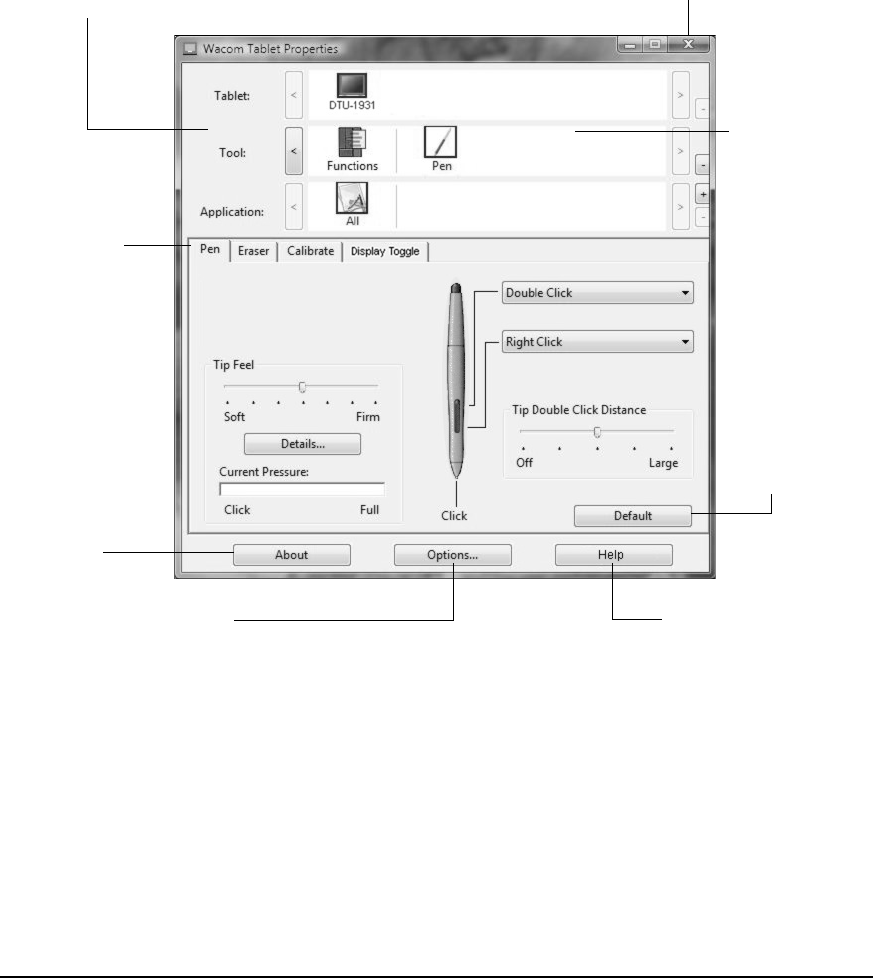
Customizing
Page 23
CUSTOMIZATION BASICS
This manual only covers the basics of customizing the DTU-1931. For detailed information see the
electronic Software User’s Manual.
Use the Wacom Tablet control panel to customize your product. When you open the control panel,
an icon for the pen is displayed in the T
OOL list and the appropriate tabs are displayed.
To customize the pen, make your changes to the tab controls. Experiment with different settings to
find what works best for you. Any changes you make will take effect immediately, but you can
always click DEFAULT to return to the factory settings.
Note: Application-specific settings are for advanced users. This topic is covered in the Software User’s
Manual.
The upper portion of the control panel displays icons representing
your TABLET, TOOL, and APPLICATIONs with custom tool settings.
Tabs display
customizable
settings for the
selected T
OOL.
Displays a dialog
box containing
information about
the pen display
tablet and tablet
software, including
an option to access
the DIAGNOSTICS
dialog box.
Displays advanced options.
Closes the control panel.
Choose PEN to
customize your
pen settings.
Choose
FUNCTIONS to
customize the
Radial Menu
settings.
For information
on working with
the Radial Menu,
see the Software
User’s Manual.
Resets the
selected tab
to its default
settings.
Displays the electronic
Software User’s Manual.
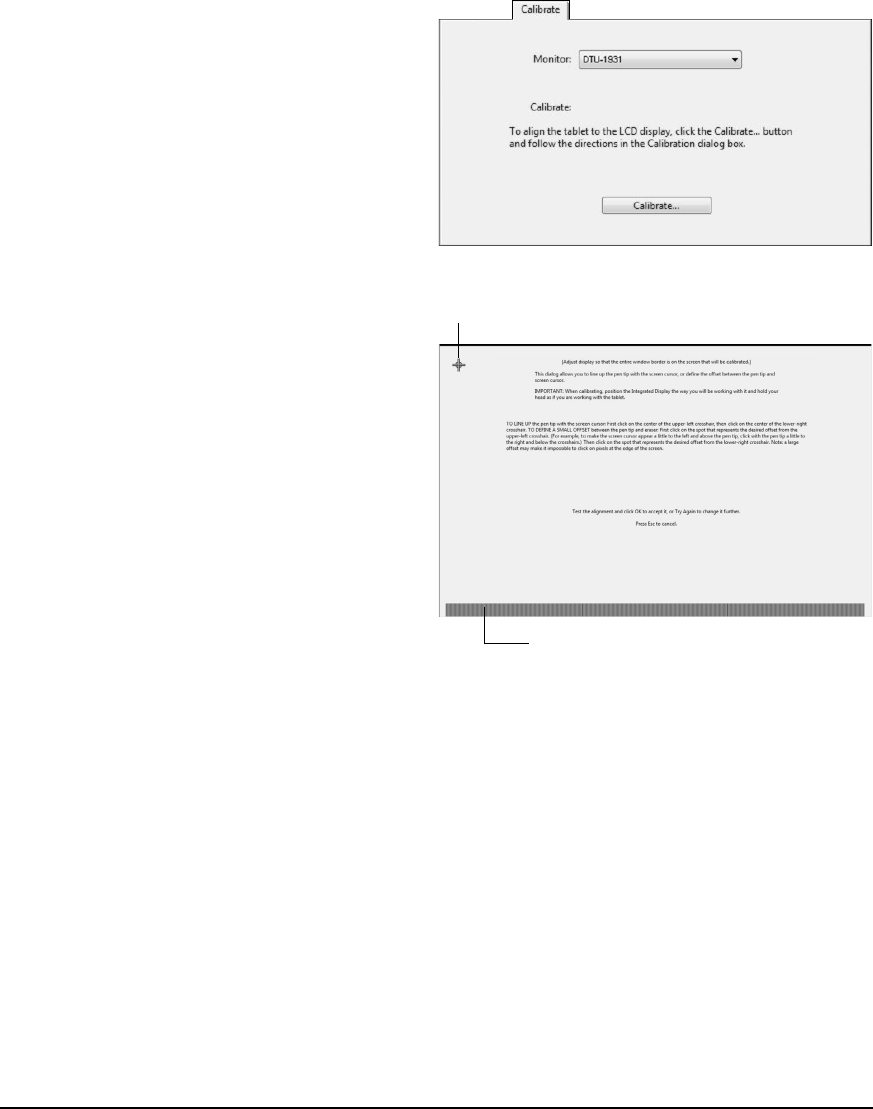
Customizing
Page 24
CALIBRATING THE DTU-1931
You must calibrate the pen display tablet in order to align the screen cursor with the position of the
pen on the display screen. This is required to adjust for parallax caused by the display screen cover
glass and coating. Set the DTU-1931 in its working position, then follow the procedure below.
IMPORTANT: When using a VGA
connection, make sure the display is
properly adjusted before calibrating the
tablet. See Adjusting pitch and phase
(VGA only) on page 28, and Adjusting the
display beginning on page 25.
• In the Wacom Tablet control panel, select the
PEN from the TOOL list and then select the
CALIBRATE tab.
• If you are working with multiple monitors, select
the MONITOR corresponding to the DTU-1931
display. (Only monitors that are set to one of the
resolutions supported by the DTU-1931 will
appear in the list.)
• Click on the CALIBRATE... button to activate the
calibration screen.
• Hold the pen and position your head as you
normally do when working with the pen display.
Use the pen tip to click on the center of the
crosshairs in the upper-left corner.
• Then click on the center of the crosshairs that
are displayed in the lower-right corner.
• Test the alignment by positioning the pen at a
few different points on the display. Click OK to
accept the calibration. Click TRY AGAIN to
recalibrate.
Be sure to read the directions in the calibration
screen for detailed instructions and additional
options. The calibration setting applies to all
applications.
Note: If more than one pen display tablet is
installed on your system, be sure to select the
unit you are working with from the control panel’s
T
ABLET list.
Crosshairs
Adjustment pattern for pitch and phase.
See Adjusting pitch and phase (VGA
only) on page 28 for details.
Tip: If you prefer to see the screen cursor slightly offset from the actual position of the pen tip, calibrate
by clicking on a spot showing that offset from the crosshairs. For example, to have the screen cursor
appear 1/10th of an inch above and to the left of the pen tip, calibrate by clicking on a spot 1/10th of an
inch below and to the right of the crosshairs.
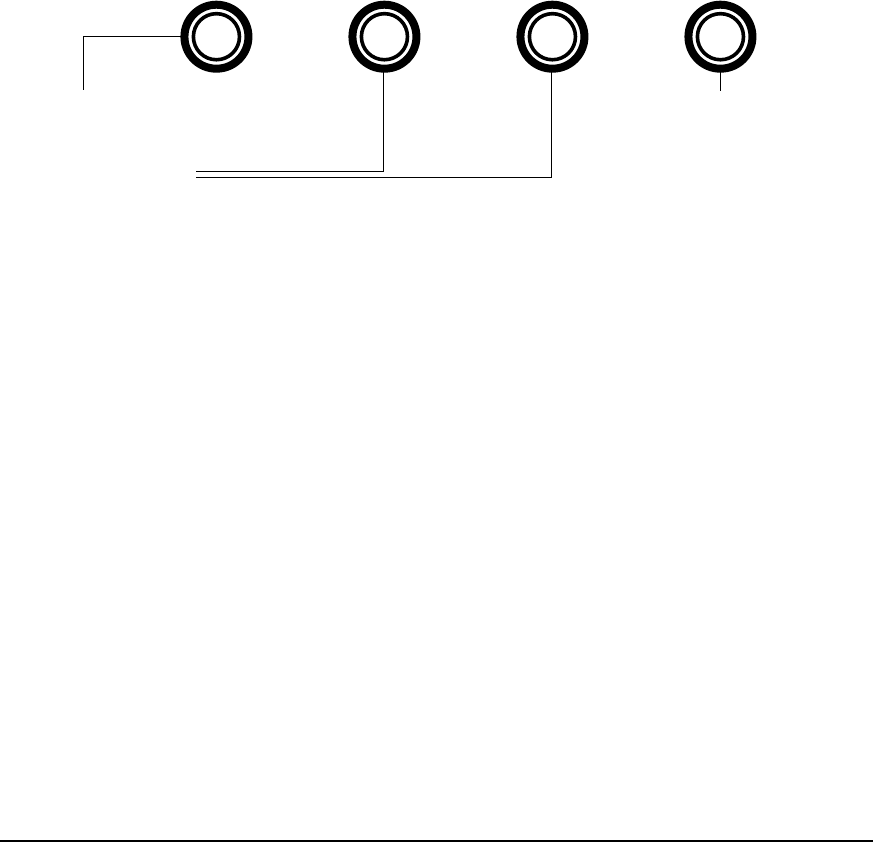
Customizing
Page 25
ADJUSTING THE DISPLAY
FACTORY PRESETS, AUTO-SYNC, AND USER SETTINGS
Factory presets: For optimal display quality, set your video card to the DTU-1931’s native
resolution of 1280 x 1024 pixels (SXGA). See page 46 for signal specifications.
Auto-sync: The DTU-1931 automatically synchronizes to the incoming signal. The auto-sync
function sets the horizontal and vertical screen position, as well as pitch and phase. Auto-sync will
function when the horizontal frequency is between 30 to 80 kHz, and the vertical frequency is
between 50 to 75 Hz.
If the DTU-1931 does not automatically synchronize with the incoming signal, you can use the OSD
AUTO ADJUST option to initiate display synchronization. Further screen display adjustments can be
manually made using the OSD controls.
Color calibration: Changing the color, color temperature, contrast, brightness, or backlight from
their default settings will invalidate the ICC color profile that was included on the driver CD.
ON SCREEN DISPLAY (OSD) SETTINGS
The OSD function enables you to optimize a variety of display settings at the touch of a button.
Make adjustments using the OSD controls located on the upper left edge of the unit.
Note: After changing a setting, the OSD menu will automatically close after a few moments of inactivity.
You can also press the MENU button to close the OSD menu. All settings are automatically saved when the
OSD menu closes and will be used the next time the unit receives a similar video signal. This is applicable
to all display modes. If you make changes to the display appearance and cannot return to the original
settings, use the RESET option to return the DTU-1931 to its original factory defaults.
1. M ENU button
Press to open or exit the OSD menu.
2. Selection buttons
Use these buttons to select an option. When the option you want to adjust is highlighted, press the ENTER
button. The current settings and adjustment sub-menu for that option will appear. Note that some settings
may not be available when in DVI mode.
Use the + or – buttons to select and adjust the option settings. (Press the + button to increase a selected
item value. Press the – button to decrease it.)
After making changes, press the ENTER button to save.
See the following pages for a detailed description of menu options.
ENTER button
Activates the selected
OSD menu option.
– +
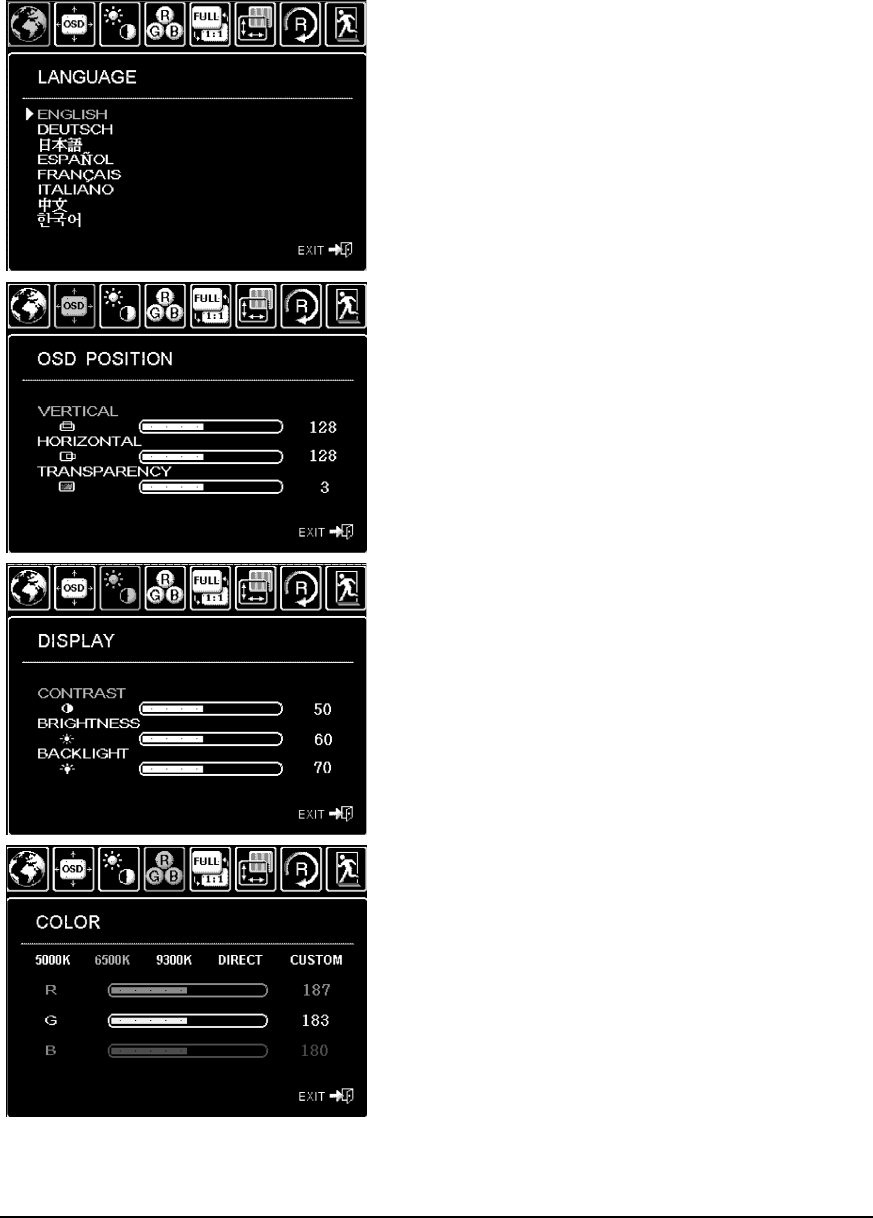
Customizing
Page 26
When you open the On Screen Display, the menu options are displayed.
LANGUAGE menu options allow you to choose the language
in which the OSD menu will be displayed.
OSD POSITION menu options include:
•V
ERTICAL. Adjusts the vertical position of the OSD menu
window.
•H
ORIZONTAL. Adjusts the horizontal position of the OSD
menu window.
•TRANSPARENCY. Changes the opaqueness of the OSD
menu background.
DISPLAY menu options include:
•B
RIGHTNESS. Increases or decreases the image
brightness.
•C
ONTRAST. Increases or decreases image contrast.
Note that changes in contrast may affect color accuracy.
•B
ACKLIGHT. Increases or decreases the backlight
brightness level.
COLOR menu options include:
• 5000K, 6500K, 9300K. Enables you to adjust the pen
display color temperature, in degrees Kelvin.
•D
IRECT displays the colors directly from the video card
without any adjustment.
•C
USTOM enables you to independently adjust the RED,
GREEN, and BLUE display colors.
Note: Any manual changes you make to the color settings
will invalidate the DTU-1931 color profile.
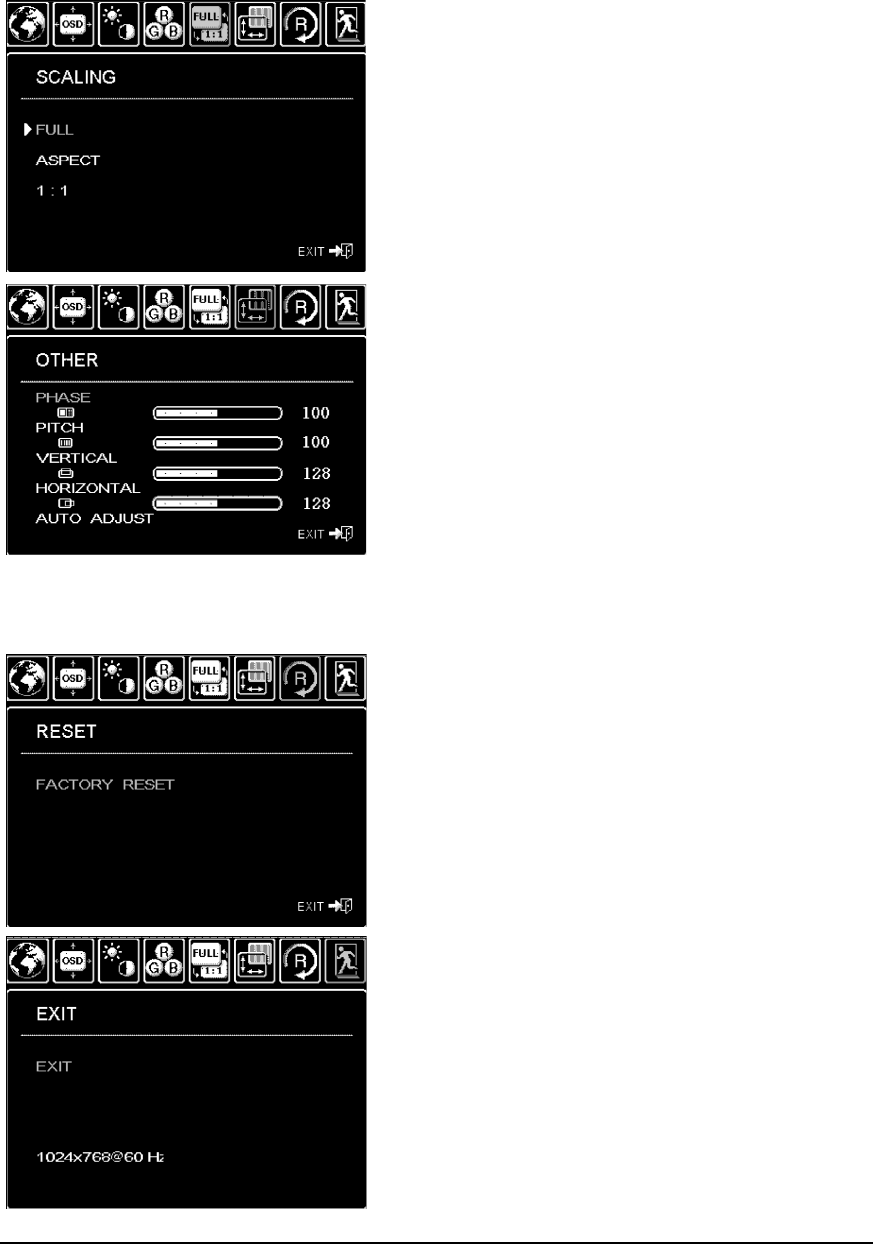
Customizing
Page 27
SCALING menu options include:
•F
ULL. Resizes the image to fill the whole screen.
•A
SPECT. Resizes the image to fill as much of the screen
as possible while maintaining the correct aspect ratio.
• 1:1. Displays the image at the actual resolution.
OTHER menu options include:
•P
HASE. (VGA only.) Synchronizes the signal timing of
the pen display to that of your graphics card. Use this
adjustment when you experience an unstable or
flickering image, or horizontal distortion lines.
•P
ITCH. (VGA only.) Changes the display data frequency
to match that of your graphics card. Use this adjustment
when you experience an unstable or flickering image, or
vertical distortion lines.
•V
ERTICAL. (VGA only.) Changes the vertical position of
the image. To automatically adjust, use the AUTO ADJUST
option.
•H
ORIZONTAL. (VGA only.) Changes the horizontal
position of the image. To automatically adjust, use the
AUTO ADJUST option.
•A
UTO ADJUST. (VGA only.) Choose this function to
automatically optimize the display screen image.
RESET returns the display parameters of the current mode to
their factory default settings.
EXIT dismisses the OSD without making changes.
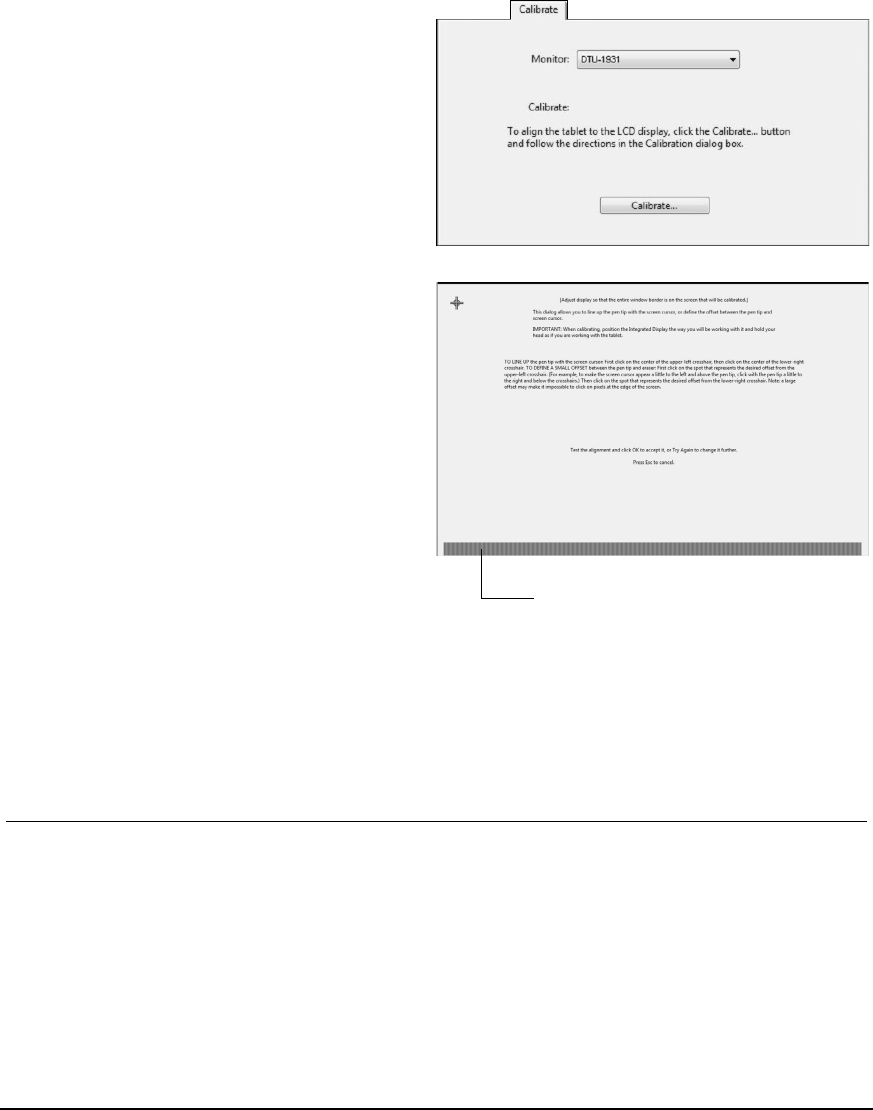
Customizing
Page 28
ADJUSTING PITCH AND PHASE (VGA ONLY)
Some computers and video cards may not allow the auto-sync function to fully work when the
DTU-1931 is first connected. If some portion of text appears blurred, use the AUTO ADJUST option to
automatically synchronize to the incoming signal (see the description about auto-sync on page 25).
If the image is still blurred, adjust pitch and phase by following the procedure below. For optimum
display quality, set your video card to the DTU-1931’s native resolution of 1280 x 1024.
POWER SAVING
The DTU-1931 conforms to VESA and ENERGY STAR® power saving guidelines.
When using the DTU-1931 with a Display Power Management Signaling (DPMS) compliant
computer or video card, the display will automatically comply with the below power saving
parameters.
When these power-saving functions are in effect, the screen display is darker than usual.
* Depending on the specifications and settings of your computer and video card, the power light may only
change to orange when in standby and suspend modes.
Computer mode H-sync V-sync Video Power consumption Power lamp
Power ON Yes Yes Active 37W, max. Blue
Standby mode No Yes Blanked 2W, max. Blue/Orange*
Suspend mode Yes No Blanked 2W, max. Blue/Orange*
OFF mode No No Blanked 1W, max. Orange
• In the Wacom Tablet control panel, select the
CALIBRATE tab.
• If you are working with multiple displays,
be sure the display corresponding to the
DTU-1931 is selected in the MONITOR menu.
• Click on the CALIBRATE... button to activate the
calibration screen.
• Using the OSD controls, open the OSD menu
and select the PITCH option. Then adjust the
pitch level so that the pattern of fine vertical
stripes displays evenly. (For details on
changing the OSD settings, see On Screen
Display (OSD) settings on page 25.)
• In the OSD menu, select the PHASE option.
Adjust the phase level so that the adjustment
pattern shows clearly.
• After completing these adjustments, press the
ENTER and MENU buttons to exit the OSD
menu.
• Click on the CANCEL button or press ESC to
exit the calibration screen.
Adjustment pattern for pitch and phase.

Troubleshooting
Page 29
TROUBLESHOOTING
Most of the time your pen display tablet will work flawlessly. But if you are having trouble, Wacom
recommends you do the following:
1. If the Wacom tablet driver failed to load properly, first perform the recommended action in any
error message that may appear on your screen. If that does not solve the problem, review the
troubleshooting procedures in this chapter.
2. If the DTU-1931 does not function properly, refer to the troubleshooting sections on the
following pages. See also Display troubleshooting on page 32, or look in the Pen tablet
troubleshooting on page 34. Your problem may be described there and you can try the solution
offered.
3. Open the Wacom pen display Read Me file for any information updates.
4. If you are having a compatibility conflict between the DTU-1931 and a new hardware or
software product, see Obtaining driver downloads on page 40 for information on downloading
an updated software driver. Wacom periodically updates the software driver to maintain
compatibility with new products.
5. Check the FAQs (Frequently Asked Questions) on the Wacom web site for your region.
6. If you have tried the suggestions in this guide and still cannot resolve the problem, then contact
Wacom for Technical Support. See the Technical support options on page 39 and the Read Me
file for information on where to obtain support for your region.
TESTING THE DTU-1931
1. If the DTU-1931 power LED does not light, check the following:
•First verify that the green light on the power adapter is on. If the light is not on, check that
the power cable is properly connected to the power adapter and to an active AC outlet.
•Check that the power adapter cable is securely connected to the DTU-1931 and that the
DTU-1931 power switch is turned on. The DTU-1931 power LED will glow orange or blue
whenever the DTU-1931 is on.
IMPORTANT: Use only the AC adapter that came with your pen display. Other adapters
may cause damage to your product.
2. If there is no display:
•Make sure that your computer is turned on. The power LED will light blue when the proper
video signal is received. It will glow orange if there is no video signal or if the computer is in
a power saving mode.
•Verify that the DTU-1931 is connected to an active VGA or DVI connector and that the
DVI/VGA switch is set to the correct video setting.
•Check that your video card has been properly installed and is functional. If you have
another display that is compatible with your video card, you can connect that display to the
card in order to verify that the video card is operating correctly.

Troubleshooting
Page 30
3. Verify that the tablet and pen are working:
•Press the pen tip against the display and verify that the status LED lights blue.
•If the LED does not light, verify that the DTU-1931’s USB cable is plugged into an active
USB port. If the DTU-1931 is plugged into a USB hub, try plugging it directly into the USB
port on your computer.
•Be sure that the USB port to which you are connecting has not been disabled. It may be
necessary to check your system BIOS setting to verify that you have connected the
DTU-1931 to an active USB port.
•The status LED will light blue when the DTU-1931 is registered as a USB device and the
pen tip is pressed against the display.
4. Check the pen. If you cannot make a selection on the display screen with the pen:
•Test the pen by pressing the pen tip or eraser (when equipped) against the surface of the
pen display tablet. The tablet status LED should light blue.
•Now, without applying pressure to the pen tip but keeping the pen within 5 mm (0.2 inch) of
the pen display tablet surface, press the side switch (when equipped). The status LED
should again light blue.
•If the status LED does not light blue for these tests, be sure you are using the correct pen
that came with your DTU-1931.
•See Testing your pen on page 31 for detailed information.
If you are still having problems, you may have a defective pen or pen display.

Troubleshooting
Page 31
TESTING YOUR PEN
If the pen does not work as you expect, it is a good idea to first check the assigned functions or
reset the pen to its default conditions. A quick way to reset a pen to its default settings is to remove
it from the TOOL list by clicking on the list’s [ – ] button. After the pen has been removed, place it
back onto the display screen surface and the pen will be re-added to the T
OOL list with its default
settings.
Open the Wacom Tablet control panel and click on the ABOUT button. In the dialog box that
appears, click on the DIAGNOSE... button to open the DIAGNOSTICS dialog box. The DIAGNOSTICS
dialog box displays dynamic information about the pen display tablet and pen. This information is
used when testing the pen display tablet and your pen.
If more than one pen display unit is connected to your system, be sure to select the unit for which
you are testing in the T
ABLET INFO column.
Note: When testing your pen buttons, if a button is set to RADIAL MENU or OPEN/RUN..., that function will
occur when the button is pressed. In this case you may want to change that button’s function before
testing.
1. While observing the POINTING DEVICE INFO column, bring your pen within 5 mm (0.2 inch) of the
display screen. A value for PROXIMITY, the DEVICE NAME, and DEVICE TYPE should be displayed.
2. Move your tool along the tablet surface. The X and Y DATA values should change to reflect the
tool position.
3. Test your pen switches. The DTU-1931 status LED should light blue each time you click with
the pen tip, press the side switch, or press the pen’s eraser to the display screen.
•Press on the display screen surface with the pen tip – the SWITCHES state and PRESSURE
value should change. (PRESSURE should change from approximately 0% with no pressure
applied to approximately 100% when full pressure is applied.)
•Next, press the side switch (when equipped) without pressing the tip to the tablet – the
SWITCHES state should change. Do this for both positions of the DuoSwitch.
•Press the pen eraser (when equipped) to the display screen – the SWITCHES state and
PRESSURE value should change. (PRESSURE should change from approximately 0% with no
pressure applied to approximately 100% when full pressure is applied.)
4. When you are done, click on the CLOSE button to exit the dialog box.
Tip = 1, DuoSwitch (lower position) = 2, DuoSwitch (upper position) = 3, Eraser = 1
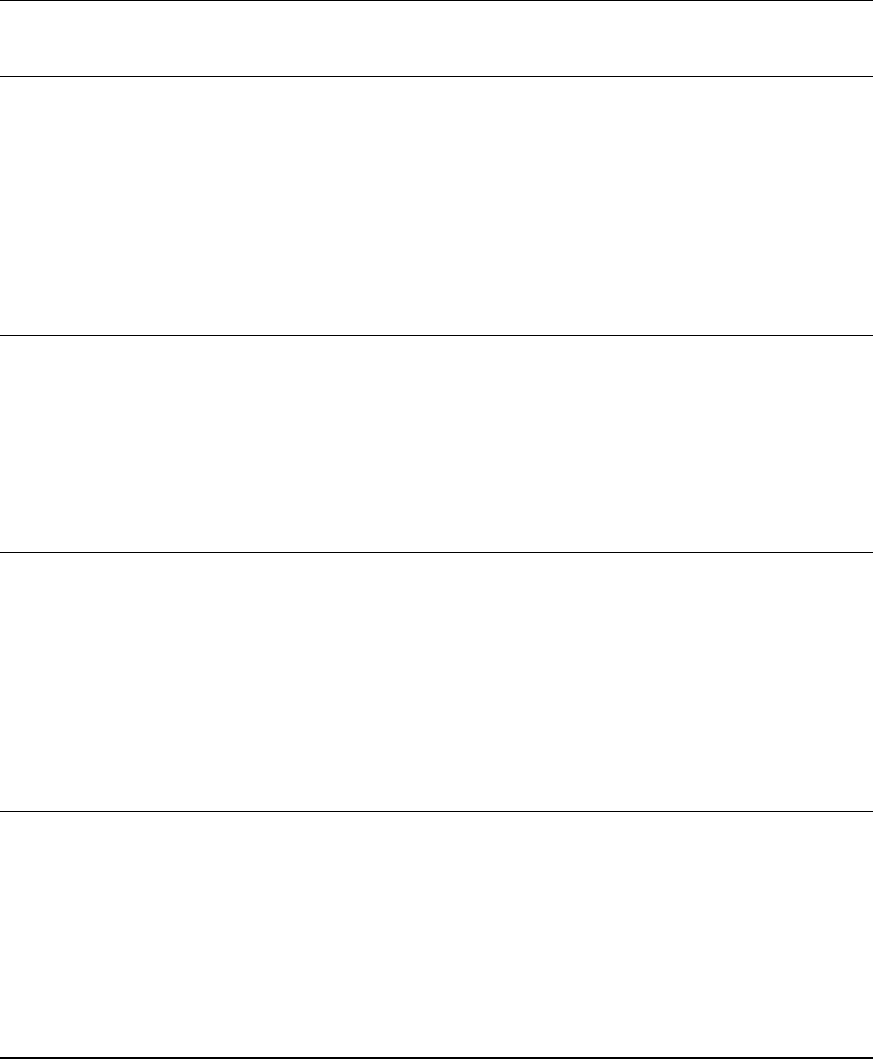
Troubleshooting
Page 32
DISPLAY TROUBLESHOOTING
If you encounter problems with the DTU-1931 display, refer to the following tables; your problem
may be described here and you can try the solution offered. For additional information about color
issues, see the documentation that came with your operating system or applications.
GENERAL DISPLAY PROBLEMS
No display. The power
LED is off. •Verify that the AC power cable is connected, and that the
DTU-1931 power switch is turned on.
No display. The power
LED is lit blue. •Check the contrast, brightness, and backlight controls.
Adjust as necessary. Or, open the OSD menu and select the
RESET option.
The power LED is lit
orange.
A ‘no signal go to power
save’ message appears
briefly on your display
screen.
•Your computer may be in a power management mode.
Touch the pen tip to the display screen, move the mouse, or
depress any key on your keyboard.
•Turn off both your computer and the DTU-1931 pen display
tablet. Check the video cable for bent or broken connector pins.
Then properly connect the video cable and turn on the
DTU-1931 and your computer.
•Verify that the DVI/VGA switch is properly set. Restart your
computer after changing the position of the switch.
•Verify that the video card is properly installed.
A ‘cable disconnect go to
power save’ message
appears briefly on your
display screen.
•Check that your computer is turned on.
•Verify that you are using the video cable that came with the
DTU-1931.
•Check that the DTU-1931 video cable is fully connected.
•Turn off both your computer and the DTU-1931 pen display.
Check the video cable and any video adapters for bent or broken
connector pins. Then properly connect the video cable and any
necessary adapters.
An ‘out of range’
message appears briefly
on your display screen.
•The input signal frequency is incorrectly set or not compatible
with the DTU-1931. Set the refresh rate (vertical frequency)
between 50 and 75 Hz. If your video card driver supports
adjustment of the horizontal frequency, make sure it is set to
some value between 30 and 80 kHz. On a single monitor system
you will need to connect a different display to change the refresh
rate.
•The resolution is set too high (1280 x 1024, maximum).
•The refresh rate is set too high (75 Hz maximum).
•Set the display properties to detect plug and play monitors.
A ‘set refresh range’
message appears briefly
on your display screen.
•The maximum refresh rate is 75 Hz. Set the refresh rate (vertical
frequency) to some value between 50 and 75 Hz.

Troubleshooting
Page 33
VGA PROBLEMS
The image appears
multiple times on the
display.
•Do not extend the video cable. Do not use an input selector
switch box.
When a still image is
displayed for a long
period of time without
refreshing the screen, an
after-image remains for a
short period of time.
•Use a screen saver or other power management feature.
Color quality is
inaccurate. •Open the OSD menu and select the RESET option.
•Be sure the DTU-1931 color profile has been installed and is
selected as the profile for use with your operating system and
applications.
•Any changes to the contrast setting should be made in small
increments as changes in contrast may affect color accuracy.
The color white does not
display as white. •Be sure the DTU-1931 color profile has been installed and is
selected as the profile for use with your operating system and
applications.
•Verify that the display is operating at the factory default settings.
If that is not sufficient, then adjust color as necessary. For details
on color management, refer to your operating system and
application documentation.
•Verify that the video cable and connector are fully connected.
The display ripples or
flickers. •Open the OSD menu and select the AUTO ADJUST option.
Then, if necessary, manually adjust pitch and phase.
•Verify that the display adapter or video card matches the
specifications for the DTU-1931.
•Adjust the refresh rate in the Display Properties control panel.
The display is not clear.
Text or other portions of
the screen appear
blurred.
•Set the display resolution of your video card to 1280 x 1024.
•Turn off the DTU-1931, then turn it back on.
•Open the OSD menu and select the AUTO ADJUST option.
If necessary, manually adjust the brightness, pitch, and phase
settings.
The display and LCD
panel are not lined up.
The display size is not
correct.
•Open the OSD menu and select the AUTO ADJUST option.
•As necessary, adjust pitch and phase, and horizontal and vertical
position. Note that some video cards may not show the display
in proper sizing.
The display ripples or
shows a moiré pattern.
The display color is not
even.
•Open the OSD menu and select the AUTO ADJUST option. If this
does not solve the problem, select the RESET option to set the
display back to the factory default settings.
•As necessary, adjust pitch and phase.
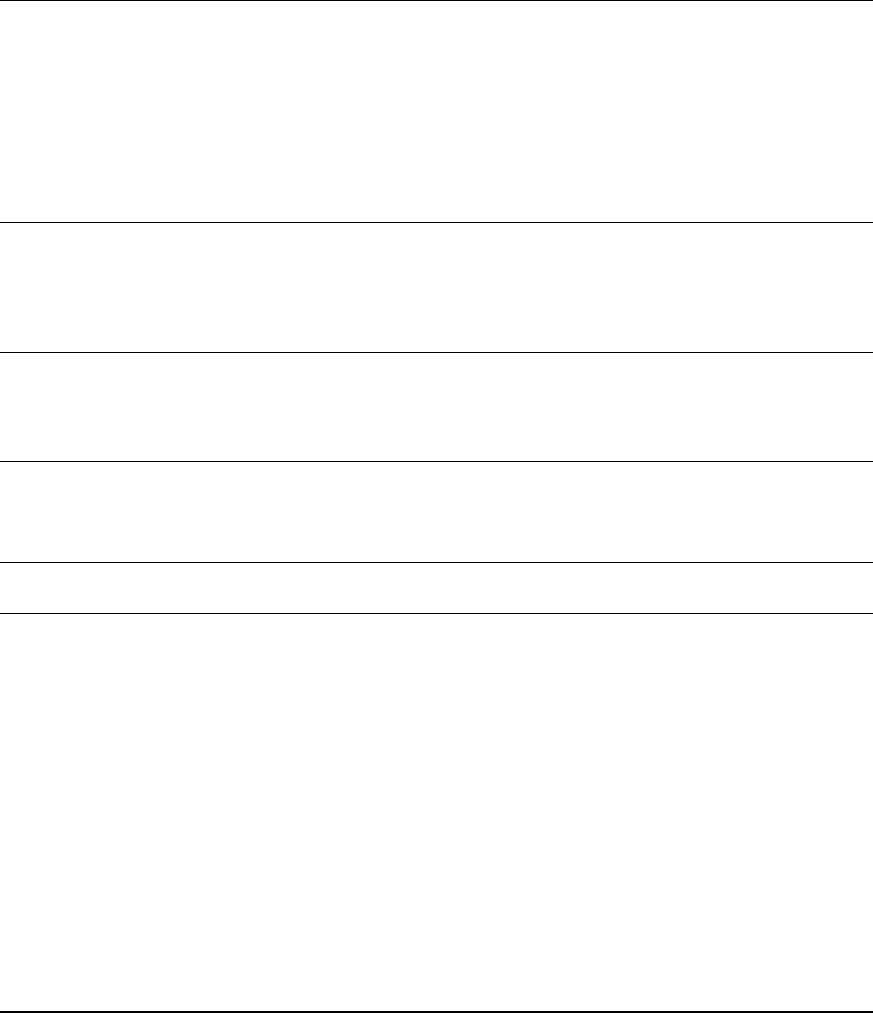
Troubleshooting
Page 34
PEN TABLET TROUBLESHOOTING
If you encounter problems with the DTU-1931 pen display tablet, see the following tables.
Your problem may be described here, and you can try the solution offered. Be sure you refer to the
DTU-1931 Read Me file for the latest information.
For additional information, visit Wacom’s web site at http://www.wacom-asia.com/support.
GENERAL PROBLEMS
The computer does not
have an available USB
port.
Check if there is an available USB port on a USB hub. If not
available you will need to add a USB hub or USB card.
A USB device plugged
into one of the pen
display’s integrated USB
ports does not function.
1. Make sure the pen display itself is properly connected to a
working USB port on your computer.
2. Then be sure the pen display is powered on and that the power
LED lights blue. The DTU-1931 contains a powered USB hub
and the integrated USB ports will not work when the power is off.
3. If the USB device does not work, try plugging it into a USB port
directly on your computer.
4. If your USB device is still not functioning properly, please contact
the manufacturer for that particular device.
The pen display power
LED is off.
Make sure the pen display power switch is turned on.
Check that the AC power adapter is plugged into both the pen display
and an active power outlet.
Use only the power adapter that came with the pen display; other
adapters may cause damage to your product.
The pen works only in
mouse mode, and does
not draw or write with
pressure sensitivity.
The tablet driver software was not installed or did not load properly.
Make sure the tablet driver software is installed and functioning.
Install the pen tablet driver software in accordance with the
instructions found in the Installation section of this guide.
The pen does not draw
or write with pressure
sensitivity.
Some applications require that you turn on the pressure capabilities
within the application or selected tool before the pen will respond as
a pressure-sensitive tool.
Verify also that your application supports pressure sensitivity.
Clicking is difficult. Open the Wacom Tablet control panel and go to the PEN tab.
Try using a lighter TIP FEEL.
The pen selects
everything or will not
stop drawing.
Open the Wacom Tablet control panel and go to the PEN tab.
Move the TIP FEEL slider toward FIRM or select DETAILS... and
increase the CLICK THRESHOLD setting. If this does not help, see
Testing your pen on page 31.
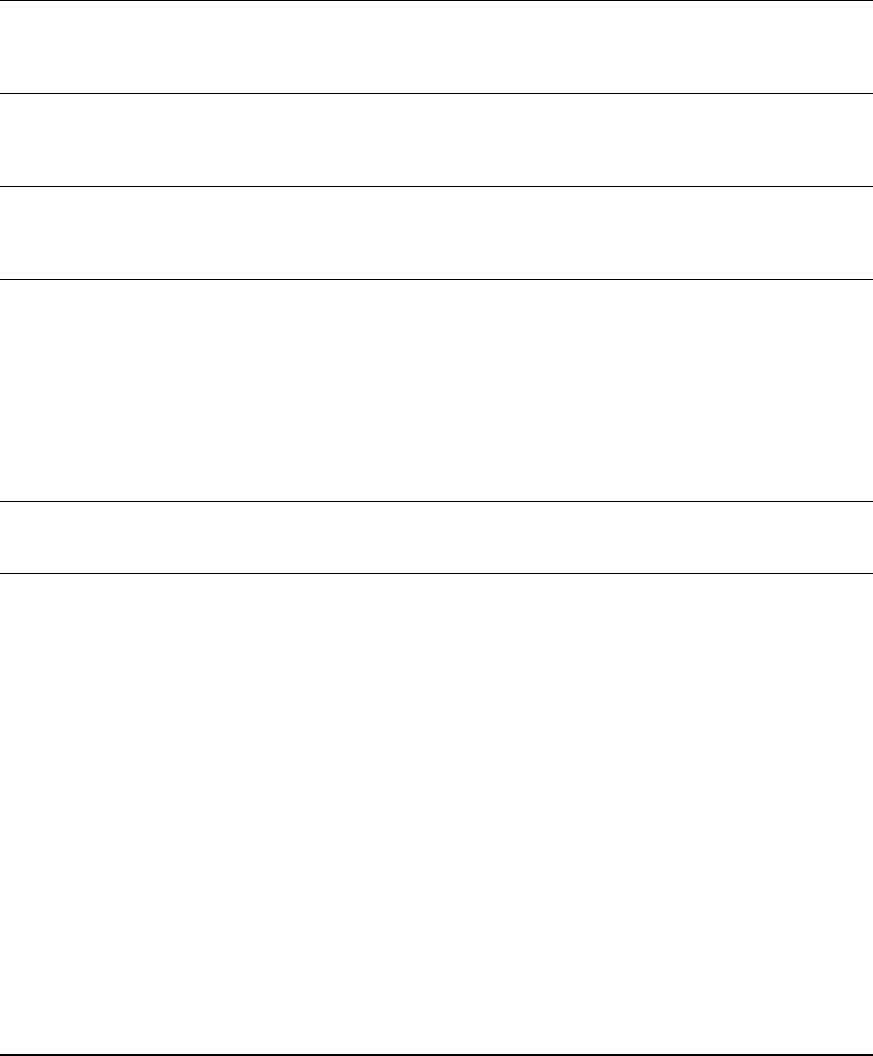
Troubleshooting
Page 35
Double-clicking is
difficult.
Be sure you are quickly tapping the display screen twice in the same
place on the pen display tablet’s active area. Wacom recommends
using the side switch to double-click.
Open the Wacom Tablet control panel and go to the PEN tab.
Try increasing the TIP DOUBLE CLICK DISTANCE or using a lighter TIP
FEEL.
Windows: Try setting your system to launch programs with a single
click. See Basic pen operations on page 20.
The eraser (when
equipped) selects
everything or will not
stop erasing.
Open the Wacom Tablet control panel and go to the ERASER tab.
Move the ERASER FEEL slider toward FIRM, or select the DETAILS...
button and increase the CLICK THRESHOLD setting. If this does not
help, see Testing your pen on page 31.
You notice a delay at the
beginning of pen or
inking strokes.
Open the Wacom Tablet control panel and go to the PEN tab.
Try decreasing the TIP DOUBLE CLICK DISTANCE. If that does not
work, try dragging the TIP DOUBLE CLICK DISTANCE slider to the OFF
position in order to turn off double-click assist.
You have to press hard
with the pen when
clicking, drawing, or
writing.
Open the Wacom Tablet control panel and go to the PEN tab.
Move the TIP FEEL slider toward SOFT, or select the DETAILS... button
and decrease the SENSITIVITY and CLICK THRESHOLD settings.
The pen tip does not
function.
Be sure you are using the pen that originally came with your
DTU-1931. Other pens may not function properly on the pen display.
Check the control panel’s PEN tab and verify that a CLICK function is
assigned to the pen tip.
Make sure the status LED lights blue when the tip is pressed. If the
LED does not light, verify that the USB cable is plugged into an active
port on your computer or on a USB hub.
If the LED still does not light, you may have defective hardware (see
Troubleshooting on page 29).
The pen tip and screen
cursor do not properly
line up.
Open the Wacom Tablet control panel and select the CALIBRATE tab.
Continue with Calibrating the DTU-1931 on page 24.
Changing the function
settings for the pen has
no effect.
Make sure you change the settings for the pen and application that
you are using. See the electronic Software User’s Manual for details
on working with application-specific settings.

Troubleshooting
Page 36
The pen side switch
does not work.
Be sure you are using the pen that originally came with your
DTU-1931. Other pens may not function properly on the pen display.
Be sure to press the side switch when the pen tip is within 5 mm
(0.2 inch) of the pen display’s active area – do this without pressing
down on the pen tip.
In the Wacom Tablet control panel, verify that the side switch is set to
the proper function you are expecting to occur for the application and
tool you are using.
Check also the SIDE SWITCH MODE. If CLICK & TAP is selected, you
will need to first press the side switch then touch the pen tip to the
tablet surface in order to perform a click function.
Make sure the status LED lights blue when you press the side switch.
If not, verify that the USB cable is plugged into an active USB port on
your computer or on a USB hub; the LED will not light if the USB
cable is not plugged into an active port.
If the LED does not light, you may have defective hardware (see
Troubleshooting on page 29).
The screen cursor
moves but it does not
jump to the pen tip
location when the pen is
placed on the display
screen, and it does not
follow the pen tip when
the pen is moved across
the display.
Make sure the Wacom tablet driver has loaded properly by opening
the Wacom Tablet control panel. If the driver did not load you will see
an error message. If an error message appears, reboot your
computer. If the problem persists, refer to the Installation instructions
and reinstall the Wacom tablet software. (For Macintosh, you must
restart your computer after installing the Wacom tablet driver for
proper tablet operation.)
If you have customized the side switch on your pen to toggle between
pen mode and mouse mode, make sure that your pen display is
operating in pen mode.
When using the pen
display tablet on a
multiple monitor system,
you cannot use the pen
to control the other
monitor(s).
Set a pen button to DISPLAY TOGGLE, and then press that button to
cycle between pen control for the DTU-1931 and your other displays.
See the electronic Software User’s Manual for details on working with
DISPLAY TOGGLE.
You can also use your pen to control the other monitors in mouse
mode. To use mouse mode, first set the pen’s DuoSwitch to MODE
TOGGLE.... Then use the switch to toggle between pen mode and
mouse mode.
The line you are drawing
does not line up with the
location of the screen
cursor.
To function properly, some applications require that the pen is set to
pen mode. Make sure the pen has not been toggled to mouse mode.
If the pen is set to pen mode and the problem still exists, then you
may have a corrupted preferences file. Follow the instructions in the
next tip to create a new preferences file.

Troubleshooting
Page 37
WINDOWS-SPECIFIC PROBLEMS
You suspect the pen
tablet preferences may
be corrupted, or want to
make certain that all
settings are at their
factory defaults.
Delete the pen tablet preferences as follows:
Windows: Click the START icon and select ALL PROGRAMS.
Then select WACOM TABLET and TABLET PREFERENCE FILE UTILITY.
In the dialog box that appears, click on the REMOVE MY PREFERENCE
FILE button to delete the preferences for the current user. To delete
preferences for multiple users, click on the REMOVE ALL PREFERENCE
FILES button. Note that administrator rights are required to delete
preferences for all users. Relaunch any currently open tablet-aware
applications that you may be running.
Macintosh: For a single user, delete the tablet preferences by first
choosing your HOME folder from the GO menu. Then open your
home LIBRARY folder. Within your home LIBRARY folder, open the
PREFERENCES folder and delete the com.wacom.wacomtablet.prefs
file. Log out, then log back in. When the tablet driver loads it will
create a new preferences file with the factory defaults.
For multiple users, delete all tablet preferences by first opening the
main APPLICATIONS folder. Then open the WACOM TABLET folder and
run the REMOVE WACOM TABLET utility. When the utility starts, click on
the REMOVE ALL PREFERENCE FILES button. The tablet driver will be
restarted, creating new preferences files with the factory defaults.
Recalibrate the tablet.
Note: Do not manually remove the WACOM TABLET.PREFPANE file from
the main LIBRARY PREFERENCEPANES folder. This file is only to be
removed when uninstalling the tablet software driver, and then only
when using the REMOVE WACOM TABLET utility.
The computer does not
go to sleep.
When you are not using the pen, remove it from the pen display
surface or the pen display will continue to send data, keeping the
computer awake.
The screen cursor jumps
back when using your
regular mouse or
trackball.
When the pen is not in use, place it in the pen storage compartment,
or at some location near the pen display – but not on the display.
Leaving your pen on the display may interfere with screen cursor
positioning when using other input devices.
The screen cursor
moves erratically or
jumps around on the
display screen when
another tablet is
connected to your
computer.
The tablet portion of the DTU-1931 emits electromagnetic waves at a
certain frequency. If another tablet is too closely placed to the
DTU-1931 it may interfere with screen cursor positioning. If this
occurs, move the tablet further away from the DTU-1931.
After changing right- and
left-handed settings in
the computer’s mouse
control panel, the pen tip
no longer functions
properly.
Restart Windows for your Wacom tool settings to be correctly
recognized.

Troubleshooting
Page 38
MACINTOSH-SPECIFIC PROBLEMS
At startup, a dialog box
appears telling you that
either the driver failed to
load or the tablet
preferences have not yet
been created.
The pen display tablet was not detected at startup. Make sure the
USB interface cable is securely connected to an active USB port on
your computer or to a USB hub. Make sure that the pen display
power LED is on. If this does not correct the problem, see
Troubleshooting on page 29.
From the GO menu, select the UTILITIES folder and launch the
SYSTEM PROFILER. Select USB from the HARDWARE section of the
CONTENTS list. A Wacom USB pen display model should be listed.
If a pen display model is not listed, check the pen display’s USB
cable connection or try plugging the pen display into a different USB
port.
If you are still having problems, go to the UTILITIES folder, open the
DISK UTILITY program, and run REPAIR DISK PERMISSIONS from the
FIRST AID tab. If this does not help, contact Wacom for Technical
Support. See Technical support options on page 39.
Inkwell does not work
correctly with the pen
display.
There may be a problem with the Inkwell preferences. Remove the
damaged preference files as follows. They will be recreated when
you enable handwriting recognition.
1. Open the System Preferences pane, choose SHOW ALL and
select INK. Then turn off handwriting recognition.
2. From the GO menu, choose your HOME. Open the LIBRARY and
PREFERENCES folders. Remove the following preferences:
•com.apple.ink.framework.plist
•com.apple.ink.inkpad.plist
•com.apple.ink.inkpad.sketch
3. Go back to SYSTEM PREFERENCES and INK, and then enable
handwriting recognition.
4. Test the Inkwell function using your Wacom pen display tablet
and pen.
5. If this procedure does not resolve your problem with Inkwell,
contact Apple Support for further assistance. Wacom is not the
software manufacturer for Inkwell and we are limited in our
abilities to support a third party software application.

Troubleshooting
Page 39
TECHNICAL SUPPORT OPTIONS
If you have a problem with your DTU-1931 pen display, first check the appropriate Installation
section in this guide to make sure the unit is installed correctly. Then review the Troubleshooting
procedures.
If you cannot find the answer in this guide, you may find updated information about your problem in
the appropriate Read Me file for your platform (located on the Wacom Pen Tablet Driver CD).
You can also check the product FAQs (Frequently Asked Questions) on the Wacom web site for
your region.
If you have an Internet connection you can download the latest software drivers from the Wacom
web site for your region. See Obtaining driver downloads on page 40.
If you cannot solve the problem and you think your Wacom product is not working properly, contact
the Wacom support staff for the area where your product was purchased. See the Wacom tablet
Read Me file, located on the Wacom Pen Tablet Driver CD, for contact information.
When you call, you should be at your computer with the following information available:
•This manual.
•Pen display serial number. (Look at the label on the back of the unit.)
•Driver version number. (See the Wacom Pen Tablet Driver CD or click on the Wacom Tablet
control panel About button.)
•The make and model of your computer, and operating system version number.
•The make, model, and connection type of your video card.
•A list of peripheral devices attached to your computer.
•The software application and version you were using when the problem occurred.
•The exact wording of any error message that appeared on your screen.
•What happened and what you were doing when the problem occurred.
•How you tried to solve the problem.

Troubleshooting
Page 40
OBTAINING DRIVER DOWNLOADS
Wacom periodically updates the pen tablet software driver to maintain compatibility with new
products. If you are having a compatibility problem between your DTU-1931 pen display and a new
hardware or software product, it may be helpful to download a new Wacom tablet software driver
(when available) from the Internet.
USA, Canada, Central and South America
Europe, Middle East and Africa
Japan
Asia Pacific (English)
China
Korea
Taiwan
Worldwide Web: http://www.wacom.com/productsupport Driver downloads.
Worldwide Web: http://www.wacom.eu Software updates.
Anonymous FTP Site: ftp://ftp.wacom.eu/pub/ Software updates.
Worldwide Web: http://tablet.wacom.co.jp Software updates.
(Japanese)
Worldwide Web: http://www.wacom-asia.com Software updates.
(English)
Worldwide Web: http://www.wacom.com.cn Software updates.
(Simplified Chinese)
Worldwide Web: http://www.wacomkorea.com Software updates.
(Korean)
Worldwide Web: http://www.wacom.com.tw Software updates.
(Traditional Chinese)
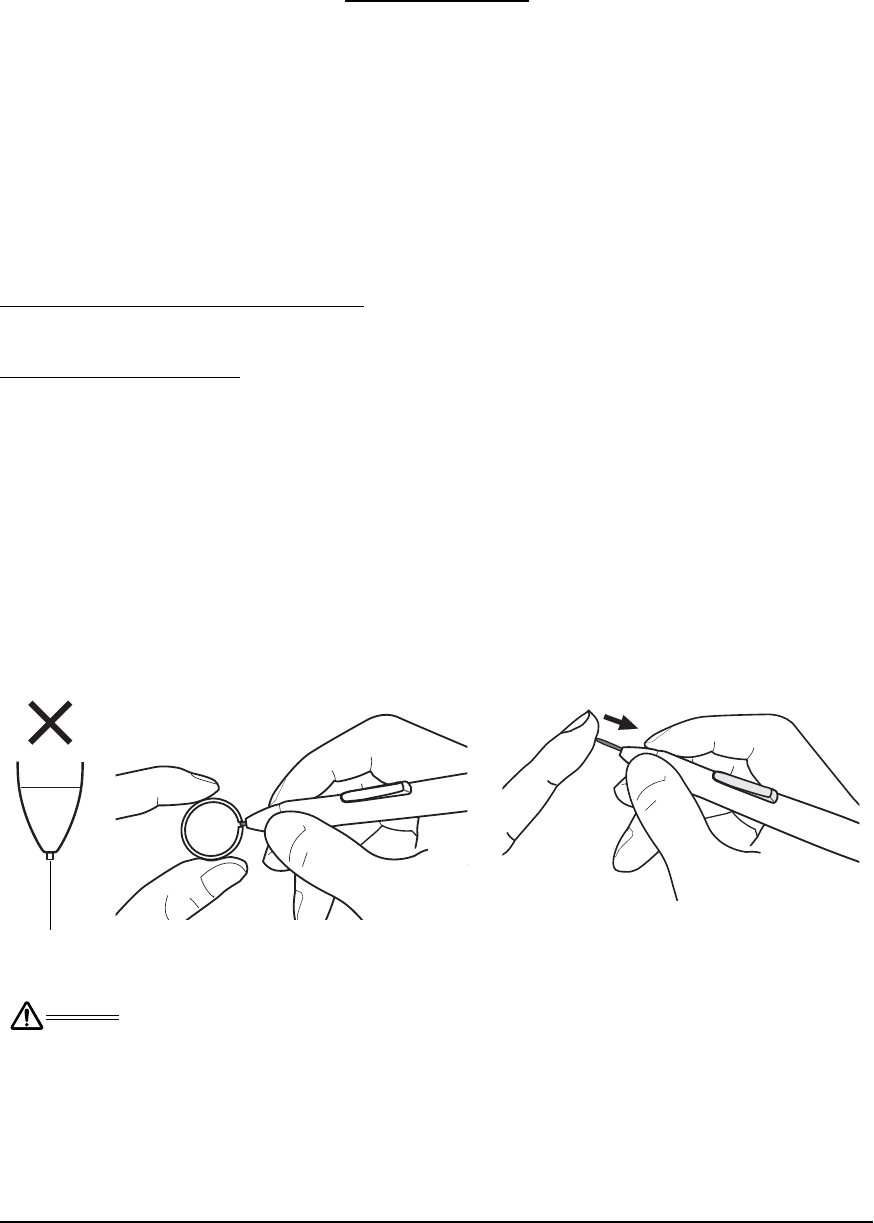
Appendix
Page 41
APPENDIX
CARING FOR THE DTU-1931
Keep the pen and the DTU-1931 LCD screen surface clean. Dust and dirt particles can stick to the
pen and cause excessive wear to the display screen surface. Regular cleaning will help prolong the
life of your LCD screen surface and pen.
Keep the DTU-1931 and pen in a clean, dry place and avoid extremes in temperature.
Room temperature is best. The DTU-1931 and pen are not made to come apart. Taking apart the
product will void your warranty.
IMPORTANT: Take care to never spill liquids onto the pen display or pen. Be especially
careful of getting the display, or pen buttons and tip wet – they contain sensitive electronic
parts that will fail if liquids enter them.
CLEANING
To clean the DTU-1931 casing or the pen, use a soft, damp cloth; you can also dampen the cloth
using a very mild soap diluted with water. Do not use paint thinner, benzine, alcohol, or other
solvents to clean the unit casing or pen.
To clean the display screen, use an anti-static cloth or a slightly damp cloth. When cleaning, apply
only a light amount of pressure to the display screen and do not make the surface wet. Do not use
detergent to clean the display screen; this may damage the coating on the screen. Please note that
damage of this kind is not covered by the manufacturer’s warranty.
REPLACING THE PEN TIP
The pen tip (nib) will wear with normal use. Excessive pressure will cause it to wear sooner. A worn
nib may damage the coating on the DTU-1931 display screen. To avoid this, periodic tip
replacement is recommended.
When the nib gets too short or develops a sharp edge, you can replace it with one of the extra nibs
that came with the pen.
IMPORTANT: When not in use, place the pen in the pen storage compartment, or lay it flat
on your desk. To maintain the sensitivity of your pen, do not store the tool in a container
where it will rest on its tip.
To remove the old nib:
Clasp it with a Wacom nib removal tool,
pair of tweezers, needle-nosed pliers, or
similar instrument and pull the old nib
straight out of the pen.
To insert a new nib:
Slide it straight into the barrel of the pen.
Firmly push the nib until it stops. The new
nib will slide into the correct position.
WARNING
Prevent children from swallowing the pen nib or side switch. The pen nib or side switch may accidentally
be pulled out if children are biting on them.
Replace the pen nib when it gets too short –
less than 1 mm (0.04 inch).
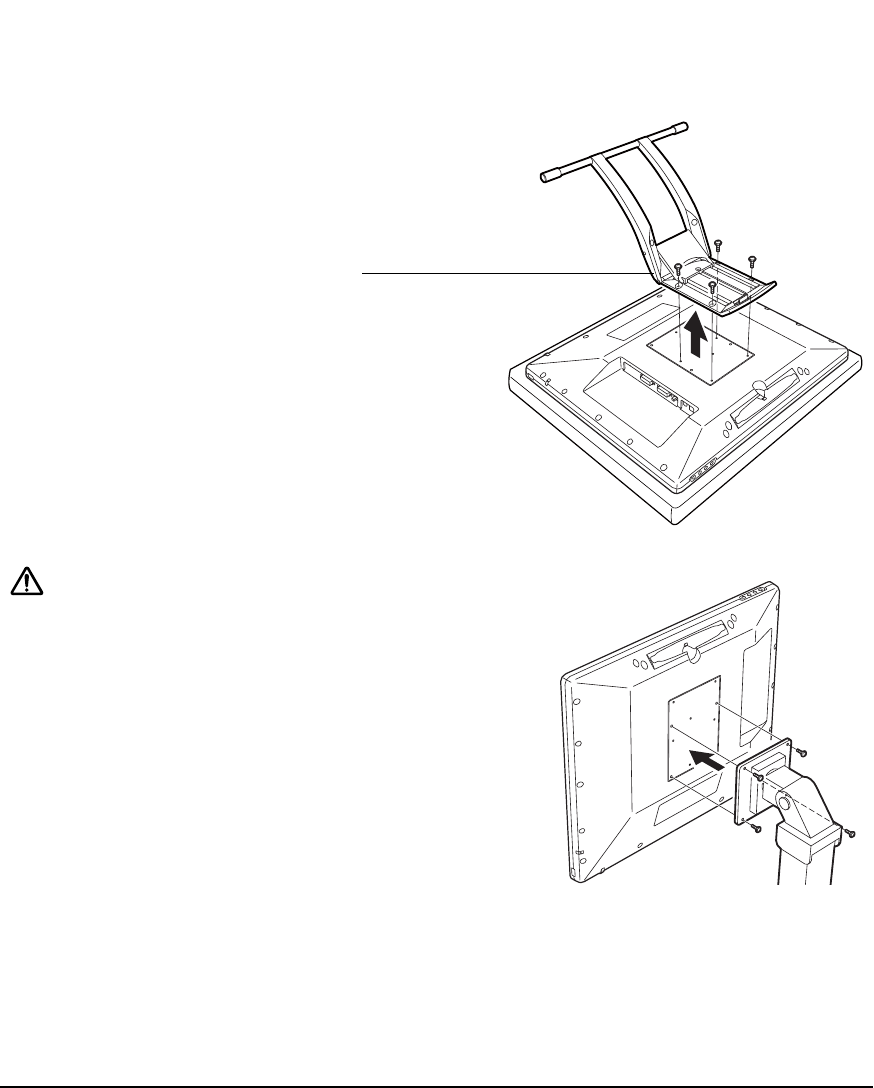
Appendix
Page 42
USING AN ALTERNATE MOUNT OR STAND
If you will be using the DTU-1931 in an installation that requires the use of an alternate mounting
platform, you can remove the adjustable stand from the unit and mount the pen display onto any
mount arm or stand conforming to the VESA 100 mm standard.
Mounting screws that are 4 mm wide with a 0.7 mm pitch (M4 Regular), with a screw clearance
depth of 15 mm are required. Exceeding the clearance depth of 15 mm will damage the pen display
internal components.
To remove the adjustable stand and
attach the pen display to a different
mounting platform:
1. Turn off your computer and power off
the DTU-1931. Then disconnect all
cables from between the unit and
your computer.
2. Protect the display screen surface by
spreading a soft cloth onto a flat
table and placing the DTU-1931 face
down on the cloth.
3. Remove the four screws and lift the
adjustable stand assembly away
from the body of the unit.
4. Using the appropriate screws for
your mounting platform, firmly attach
the DTU-1931 to the alternate
mounting platform.
5. Refer to the Installation instructions,
beginning on page 11, and reattach
the cabling.
CAUTION
When attaching the DTU-1931 onto an alternate
mounting platform, be sure to follow all instructions
in the documentation supplied by the platform
manufacturer. If improperly installed, the unit could
fall, resulting in damage to the unit or physical injury.

Appendix
Page 43
PEN AND DIGITAL INK CAPABILITIES IN WINDOWS VISTA
Microsoft Windows Vista provides extensive support for pen* and touch input. When using the
DTU-1931 with a computer running Windows Vista, your experience is enhanced by powerful note
taking, handwriting recognition, fast navigation, and other digital inking options designed to give you
quick, intuitive results with the Wacom pen.
•Note taking. Use your Wacom pen to jot notes and capture quick sketches in Windows
Journal. Journal simulates a physical notebook, but with the advantages of digital note taking –
you can choose from a variety of pen, marker, and highlighter tools. Journal also includes a
powerful search engine that can even locate your handwritten content.
•Handwriting recognition. Because Windows Vista includes powerful handwriting recognition
capabilities, you can use your Wacom pen to quickly enter handwritten information anywhere
the computer accepts typed input. You can convert your handwritten content to typed text at
any time.
•Gestures. Use your Wacom pen to make simple gestural movements on the pen display to
trigger customizable actions for navigation, editing, and other functions. To customize your
gestures, select the FLICKS tab in the PEN AND INPUT DEVICES control panel.
•Digital Ink in Microsoft Office 2007. Use your Wacom pen to full advantage with the
enhanced digital mark-up and inking tools available in Microsoft Office 2007 applications
running on Windows Vista. Found on the REVIEW tab within applicable applications, these tools
provide a consistent set of inking options. For quick access, you can add specific inking tools to
the Quick Access Toolbar located at the top of each application.
Note that the following workarounds in the pen tablet driver improve drawing performance in Vista:
•The Vista Pen Flicks and ‘press-and-hold-to-right-click’ features are disabled in graphics
applications using the Wintab API.
•There is no pressure sensitivity in Journal and other Vista Ink features when both the Flicks and
‘press-and-hold-to-right-click’ features are disabled in the Vista PEN AND INPUT DEVICES control
panel.
* Pen features supported in all versions of Windows Vista except Vista Home Basic.

Appendix
Page 44
ABOUT THE WINDOWS VISTA TABLET PC INPUT PANEL
The Input Panel enables you to use handwriting or an on-screen keyboard to directly enter text with
your Wacom pen. There are different ways to launch the Input Panel:
•Click on the Input Panel icon which appears when you move the screen cursor into a text entry
area.
•Click on the Input Panel tab, located by default on the left edge of the display screen.
•Click on the Tablet PC Input Panel icon located on the Windows taskbar. If the icon is not
visible, right-click on the taskbar, select TOOLBARS, and TABLET PC INPUT PANEL.
To customize the Input Panel:
1. First open the Input Panel and then click on T
OOLS in the menu bar.
2. Select OPTIONS to open the Input Panel Options dialog box.
3. Customize the Input Panel settings for the way you like to work.
To learn more about using your Wacom pen in Microsoft Windows Vista and Office 2007, study the
documentation that came with your system and Microsoft Office applications. Be sure to take
advantage of the Windows Vista training tools, including the Tablet PC tutorial, available from
Microsoft.
You can visit also the Wacom web site at www.wacom-asia.com/vista for additional information on
working with your Wacom pen in Windows Vista.

Appendix
Page 45
UNINSTALLING THE DTU-1931
Follow the appropriate procedure below to remove the Wacom tablet software and the DTU-1931
from your system.
IMPORTANT: When you remove the Wacom tablet software from your system, your Wacom
tablet will no longer operate with full tablet functionality but will continue to function as a
mouse device.
Windows:
1. Click on the Windows START button and open the CONTROL PANEL.
2. In the CONTROL PANEL window for
•Windows Vista: click on UNINSTALL A PROGRAM. In the dialog box that appears, choose the
WACOM TABLET option and click on the UNINSTALL button.
•Windows XP or XP x64: select ADD OR REMOVE PROGRAMS. In the ADD OR REMOVE
PROGRAMS window, choose WACOM TABLET and click on the REMOVE button.
3. Follow the prompts to remove the tablet driver. (If prompted, enter your administrator login
name and password.)
4. When the driver has been removed, shut down your system, power off your computer, and turn
off the DTU-1931. When your computer and the DTU-1931 are off, disconnect the DTU-1931
from your computer.
Macintosh:
1. Fr o m t h e G O menu, choose APPLICATIONS and open the WACOM TABLET folder.
2. Double-click on the REMOVE WACOM TABLET icon and select the REMOVE TABLET SOFTWARE
button. Enter your administrator login name and password.
3. After the removal is completed, click OK.
4. Shut down your computer and turn off the DTU-1931. When your computer and the DTU-1931
are off, disconnect the DTU-1931 from your computer.

Appendix
Page 46
PRODUCT SPECIFICATIONS
GENERAL SPECIFICATIONS
DISPLAY
PEN TABLET
Physical dimensions (W x D x H) 452.0 x 398.0 x 55.5 mm (17.8 x 15.7 x 2.2 in), excluding stand
Weight 7.05 kg (15.5 lb), including stand
Input voltage 12 VDC
Power consumption 37W or less
Operating temperature and humidity 5° to 35° C, 20 to 80% RH (non-condensing)
Storage temperature and humidity -20° to 60° C, 20 to 90% RH (non-condensing)
(maximum storage humidity is 38% at a temperature of 60° C, and
maximum storage temperature is 42° C at a humidity of 90%)
Certification and compliance FCC part 15 class B & Subpart C, Industry Canada Class B, CE,
VCCI Class B, EDID 1.3, C-tick, BSMI, MIC, CCC, GOST-R, CB,
J-MOSS, The European Union RoHS Directive 2002/95/EC,
Chinese RoHS, Korean RoHS
Display a-Si TFT active matrix LCD
Screen size 19.0 in, diagonal
Resolution 1280 x 1024 (SXGA), 1024 x 768 pixels (XGA),
800 x 600 pixels (SVGA), 640 x 480 pixels (VGA)
Synchronization range 50 to 75 Hz vertical, 30 to 80 kHz horizontal
Pixel pitch 0.294 x 0.294 mm (0.012 x 0.012 in)
Color depth 16.7 million
Luminance 270 cd/m2 (typical)
Contrast ratio 1300:1, typical
Plug and Play DDC2B, DDC/CI, and other DVI standards
LCD quality Each DTU-1931 LCD panel is produced under very stringent
quality standards. Production techniques cannot guarantee an
absolutely perfect TFT display. Wacom does not allow any pixel to
be always white or always black. A small number of pixels (4 or
less) are allowed to show a wrong color for some parts of the color
spectrum. This does not mean the display is defective.
Reading technology Electromagnetic resonance method
Active area 378.3 x 303.1 mm (14.91 x 11.94 in)
Resolution 0.01 mm/point (2540 lpi)
Accuracy ±0.5 mm (±0.02 in), average
Reading height 5 mm (0.2 in)
Maximum report rate 133 points/sec.
Pressure levels 512 levels
Communication interface USB v2.0
Integrated USB hub USB v2.0
Powered hub with two external ports, 500 mA per port

Appendix
Page 47
POWER ADAPTER
PEN (MODEL UP-817E)
ORDERING PARTS AND ACCESSORIES
To purchase parts and accessories, please contact local Wacom offices or distributors:
www.wacom-asia.com/support/contact.
Input voltage 100 to 240 VAC, 50/60 Hz
Output voltage 12 VDC, 5.0 A (max)
Pressure levels 512
Pen tip travel 0.2 mm (0.008 in) or less
Physical dimensions (L x D) 147.5 x 12.5 mm (5.81 x 0.49 in)
Weight 12 g (0.42 oz), approximately
Side switch type Rocker switch
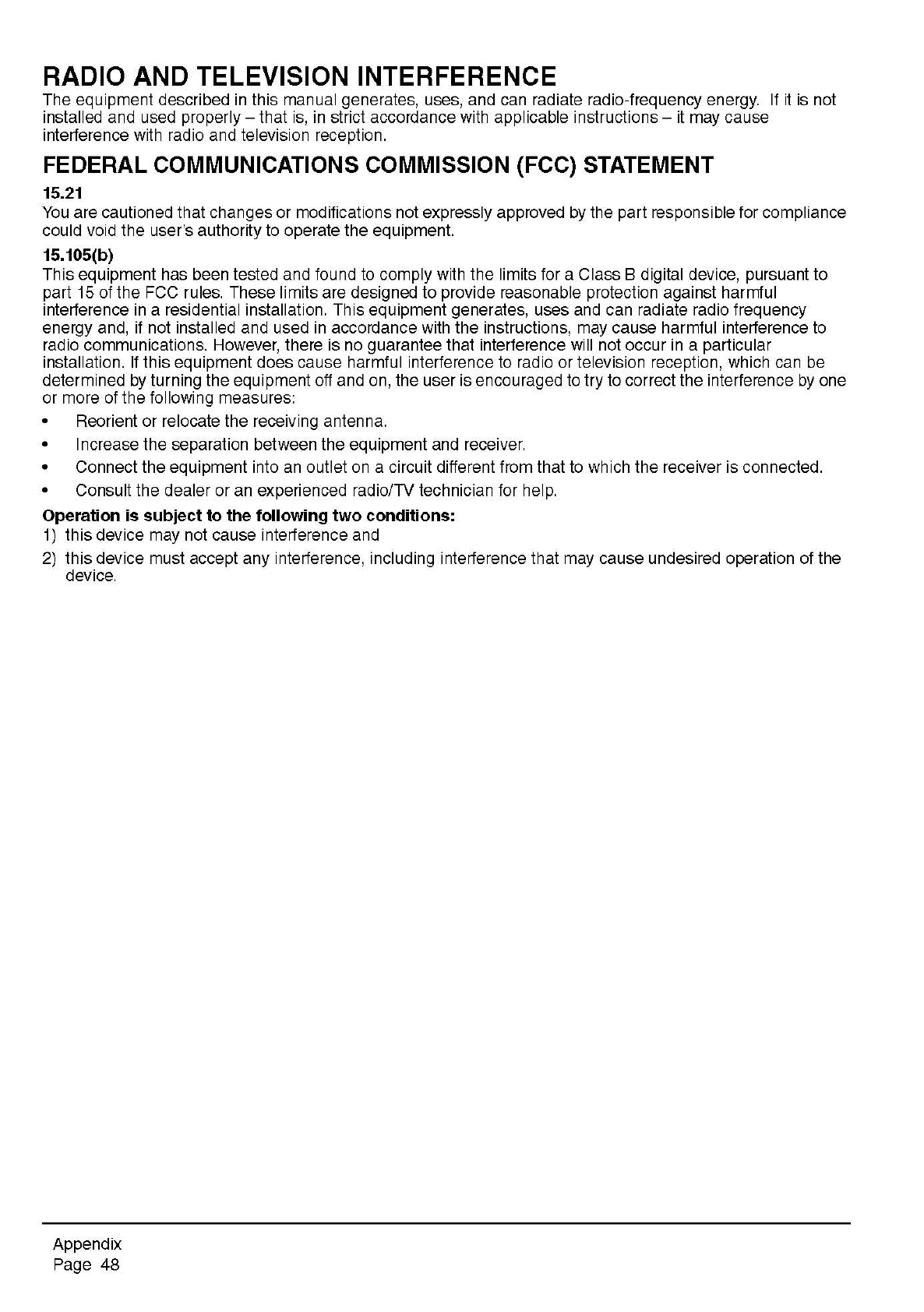

Appendix
Page 49
INDUSTRY CANADA (IC) STATEMENT
15.21
You are cautioned that changes or modifications not expressly approved by the part responsible for compliance
could void the user’s authority to operate the equipment.
15.105(b)
This equipment has been tested and found to comply with the limits for a Class B digital device, pursuant to
part 15 of the IC rules. These limits are designed to provide reasonable protection against harmful interference
in a residential installation. This equipment generates, uses and can radiate radio frequency energy and, if not
installed and used in accordance with the instructions, may cause harmful interference to radio
communications. However, there is no guarantee that interference will not occur in a particular installation. If
this equipment does cause harmful interference to radio or television reception, which can be determined by
turning the equipment off and on, the user is encouraged to try to correct the interference by one or more of the
following measures:
• Reorient or relocate the receiving antenna.
• Increase the separation between the equipment and receiver.
• Connect the equipment into an outlet on a circuit different from that to which the receiver is connected.
• Consult the dealer or an experienced radio/TV technician for help.
Operation is subject to the following two conditions:
1) this device may not cause interference and
2) this device must accept any interference, including interference that may cause undesired operation of the
device.

Appendix
Page 50
CE DECLARATION (APPLICABLE TO THE EUROPE)
The DTU-1931 pen display has been tested and found to comply to the following harmonized European Norms:
Based on the results of these tests, Wacom declares that the above mentioned device conforms to the EMC
Directive 2004/108/EC.
The device must be installed and operated always in strict accordance to the instructions given in this manual.
Any changes or modifications to this product that were not specifically authorized by Wacom will invalidate this
declaration.
WARRANTY FOR ASIA PACIFIC (EXCLUDING JAPAN, CHINA AND
HONG KONG*)
Wacom Co., Ltd. warrants the product, to the original consumer purchaser, including the main unit and
accessories such as the AC adapter and cables, to be free from defects in materials and workmanship under
normal use and service for a period of one (1) year, from the date of original retail purchase, as evidenced by a
copy of the receipt (proof of purchase) and registration with Wacom online within 30 days of purchase.
The Software is licensed “as is.” Wacom makes no warranty with respect to its quality or performance. Wacom
cannot guarantee you uninterrupted service or the correction of any errors. Wacom also makes no warranty for
consumable items such as pen nibs, etc.
Upon discovery of a defect in the product, except in the software, within the warranty period, the warranty
holder should contact the original place of purchase to obtain instructions for returning the product for repair or
replacement. Wacom and its partners are not obligated to reimburse unauthorized prepaid shipment.
To read the full warranty statement for this product, please visit: www.wacom-asia.com/technical/warranty
This Limited Warranty is governed by the laws of Japan and is subject to change without prior notice.
Warranty Service in Asia Pacific:
Please contact your local distributor or Wacom office for warranty service and repair.
www.wacom-asia.com/support/contact
--------------------------------
(*For warranty info in China and Hong Kong, please see the warranty included with this product or contact
Wacom China: www.wacom.com.cn)
EN55022: 1998+A1:2000+A2:2003 Class B EN61000-3-2: 2006
EN61000-3-3: 1995+A1:2001+A2:2005
EN55024: 1998+A1:2001+A2:2003 IEC61000-4-2: 1995+A1:1998+A2:2000
IEC61000-4-3: 2006 IEC61000-4-4: 2004
IEC61000-4-5: 2005 IEC61000-4-6: 2003
IEC61000-4-11: 2004